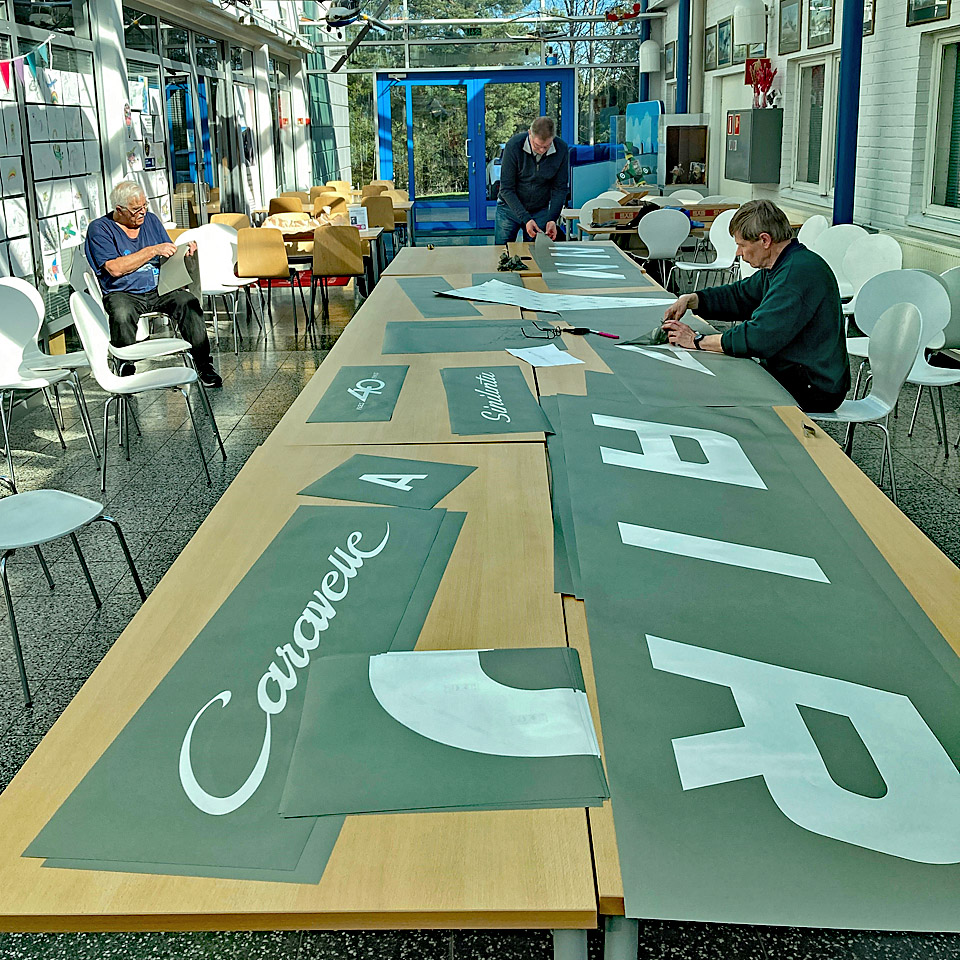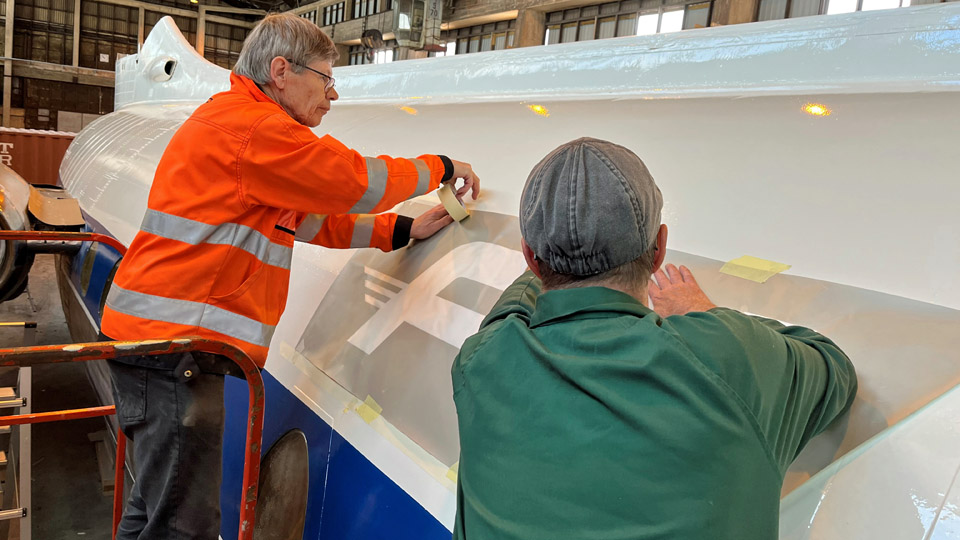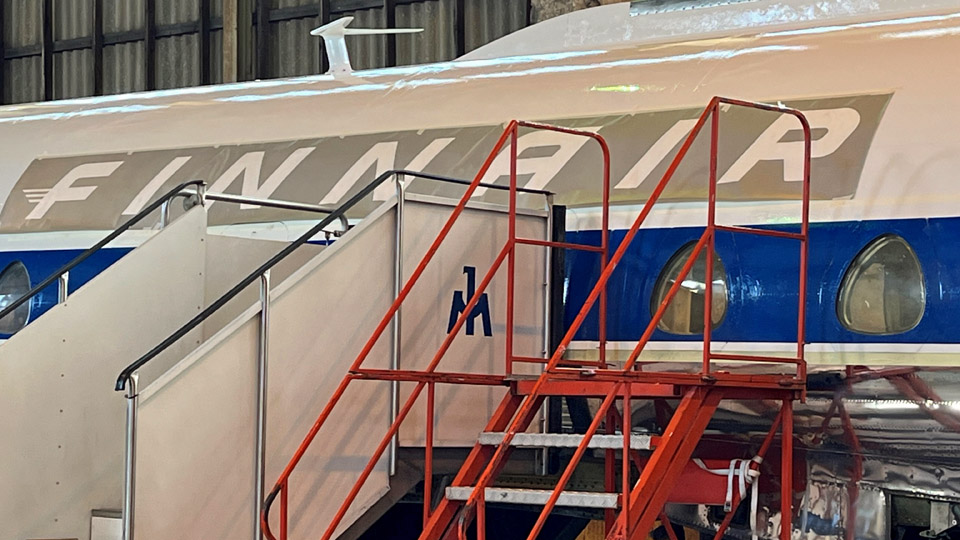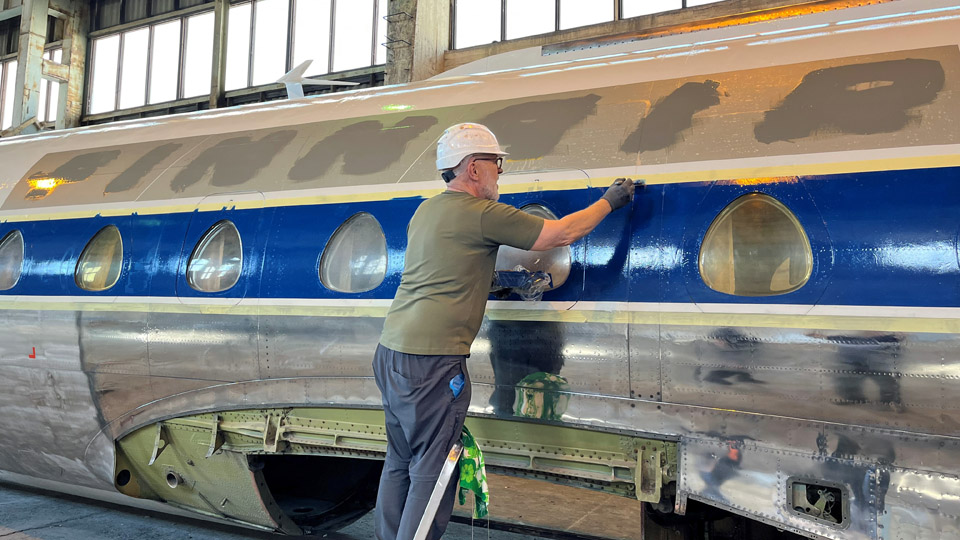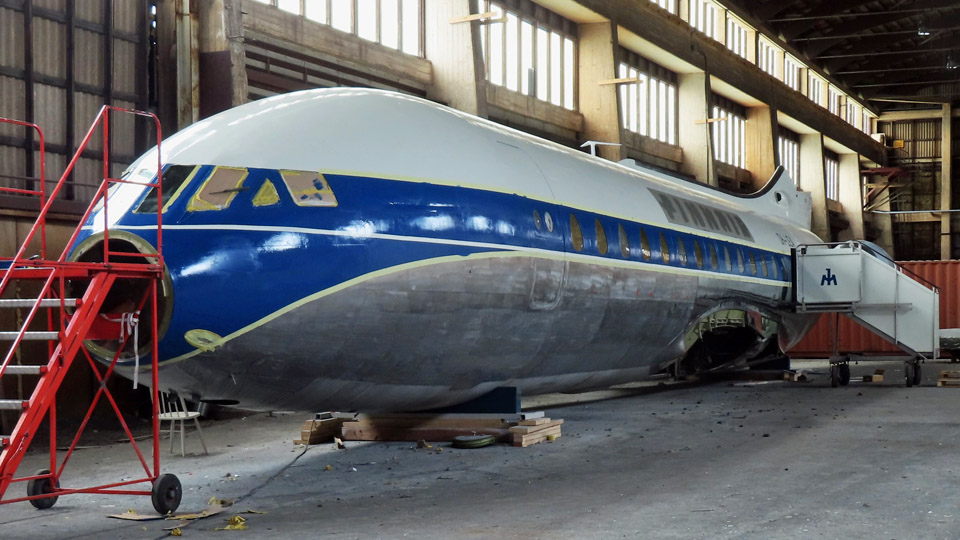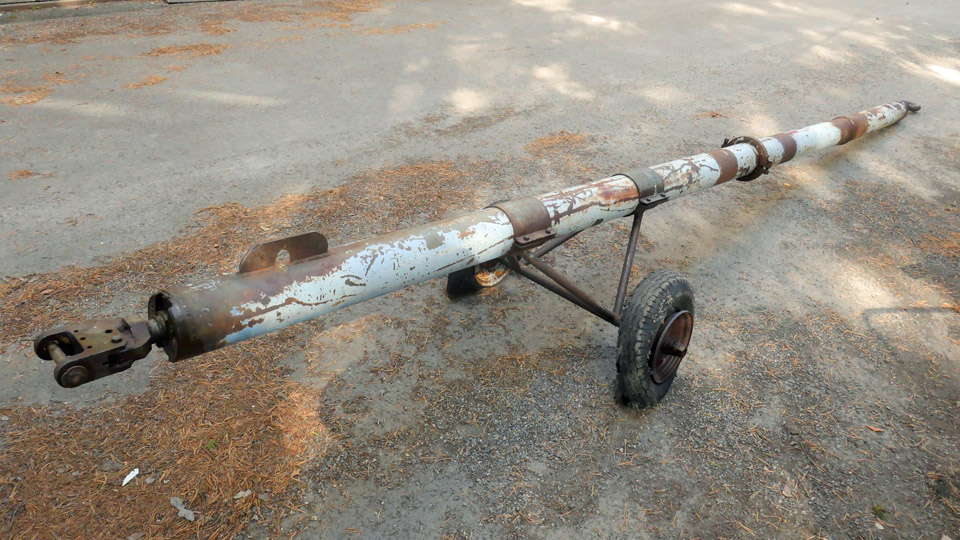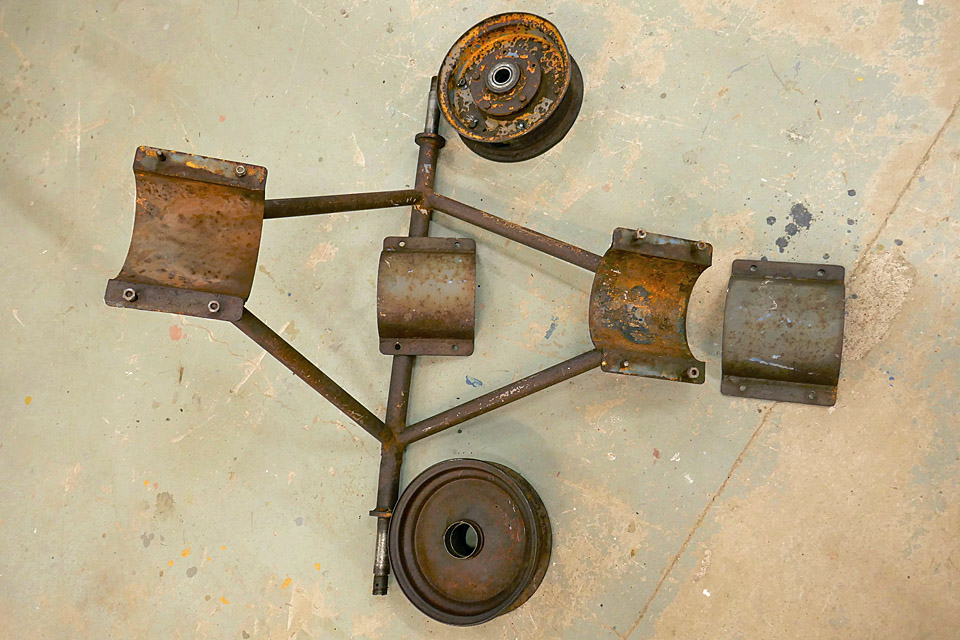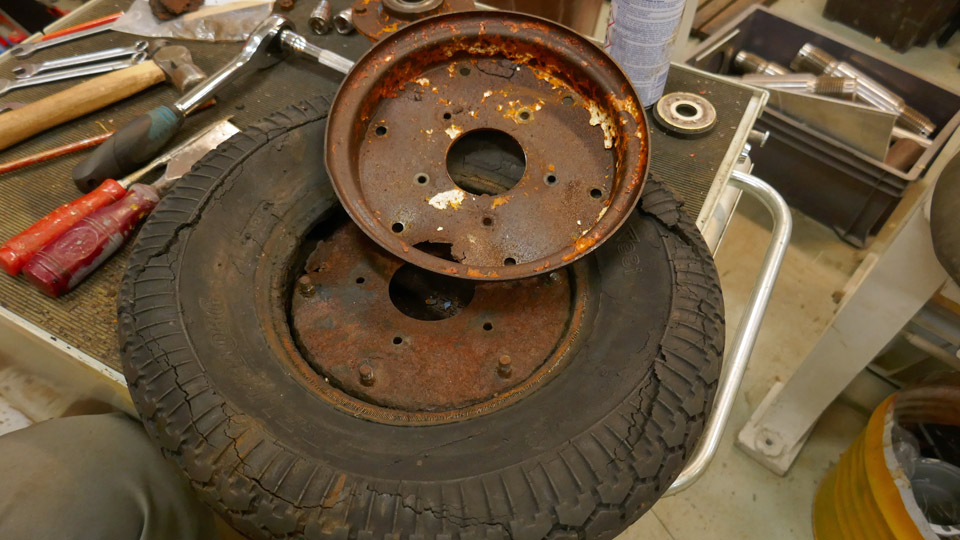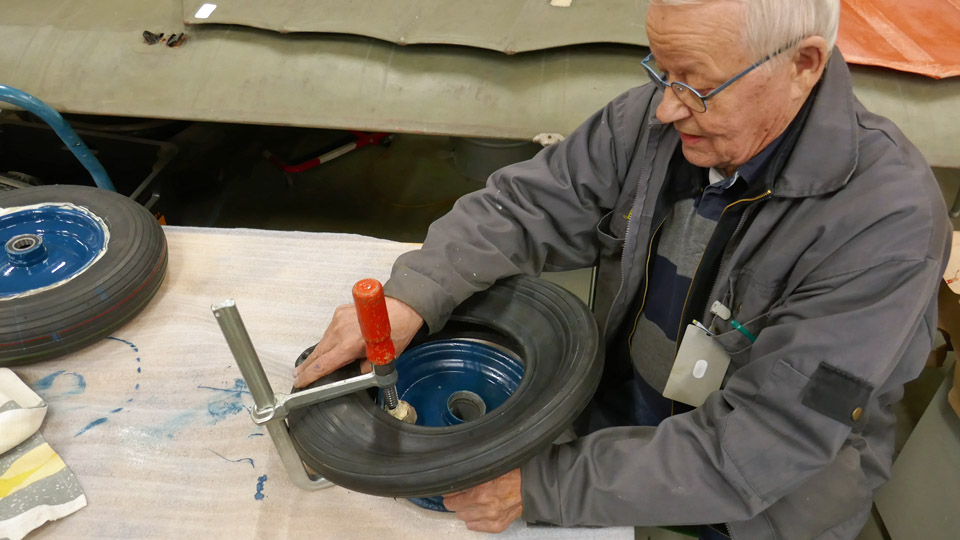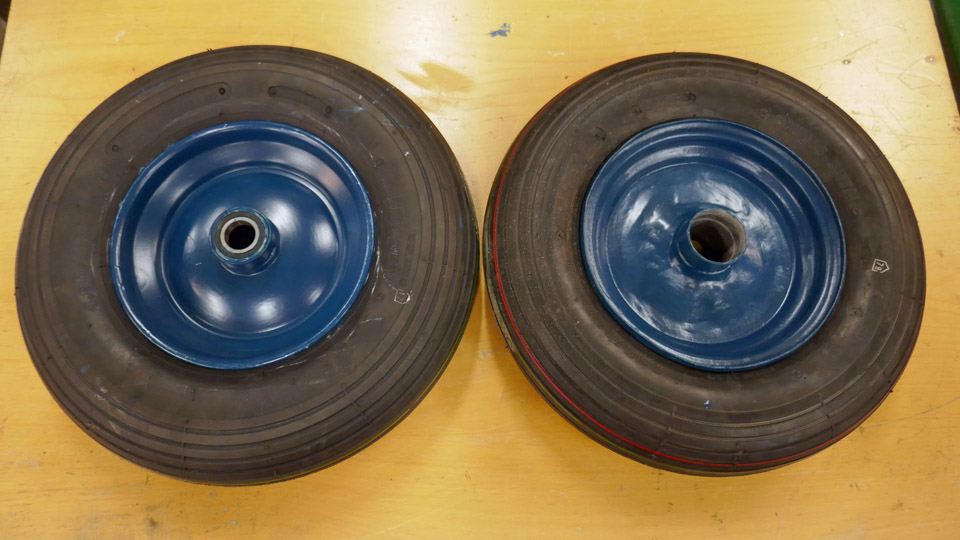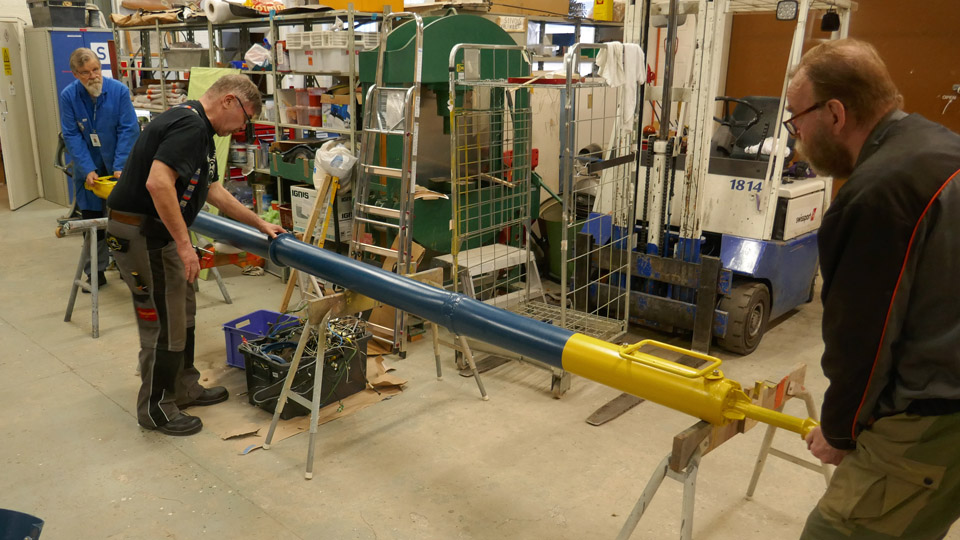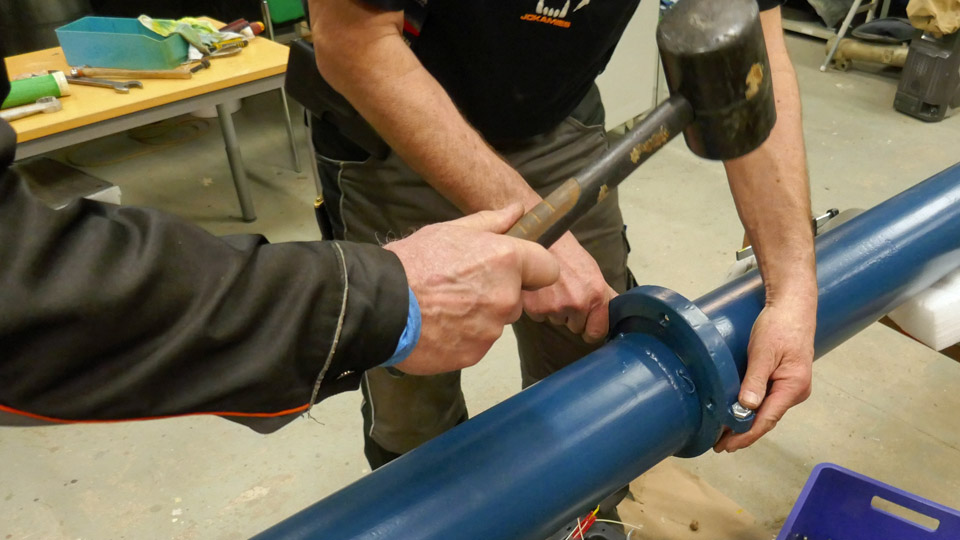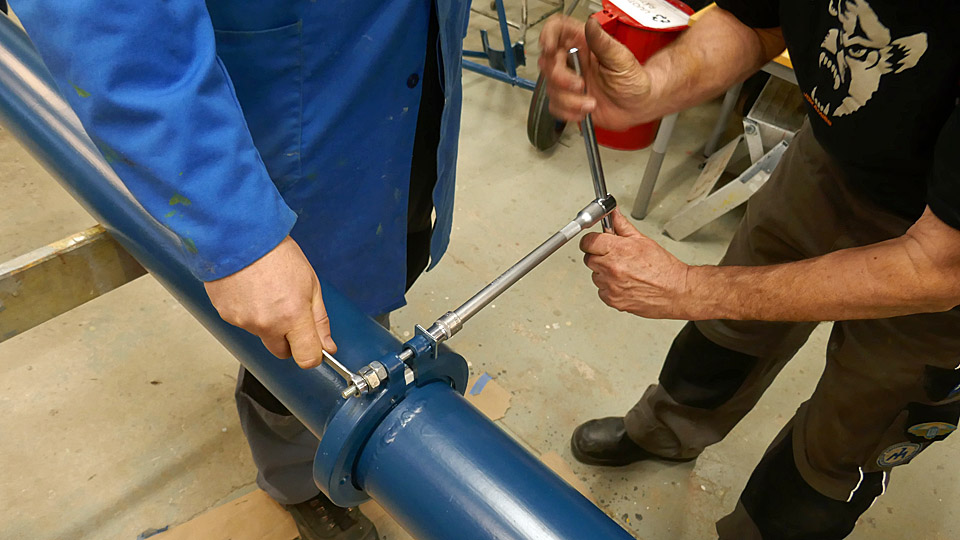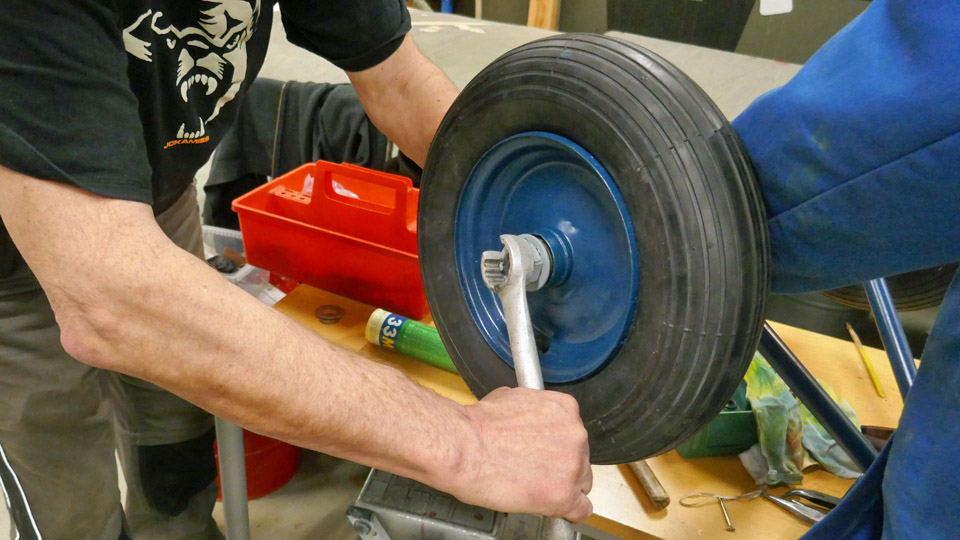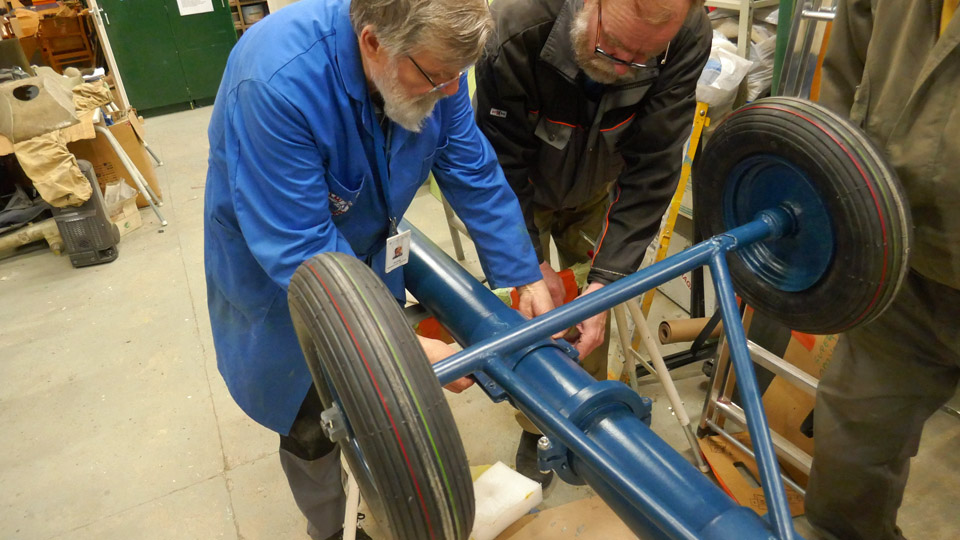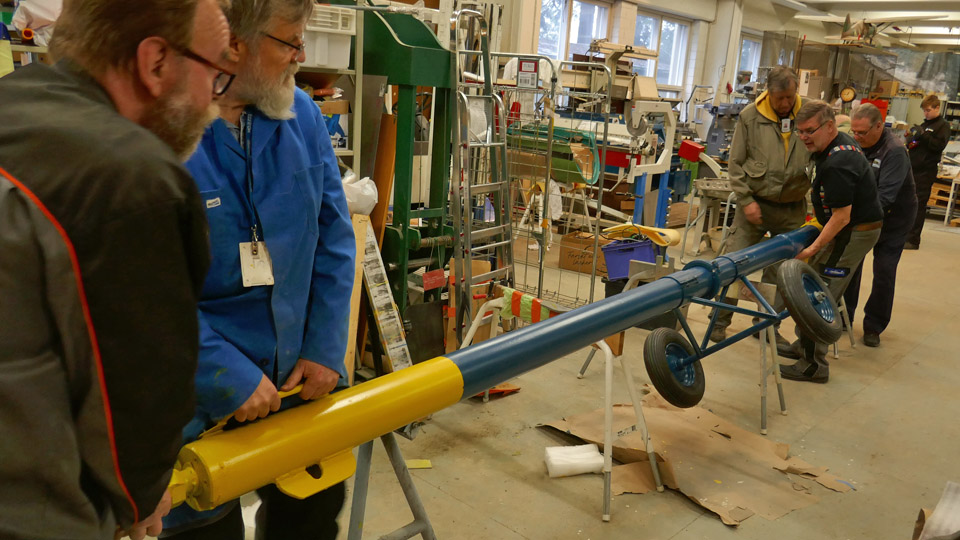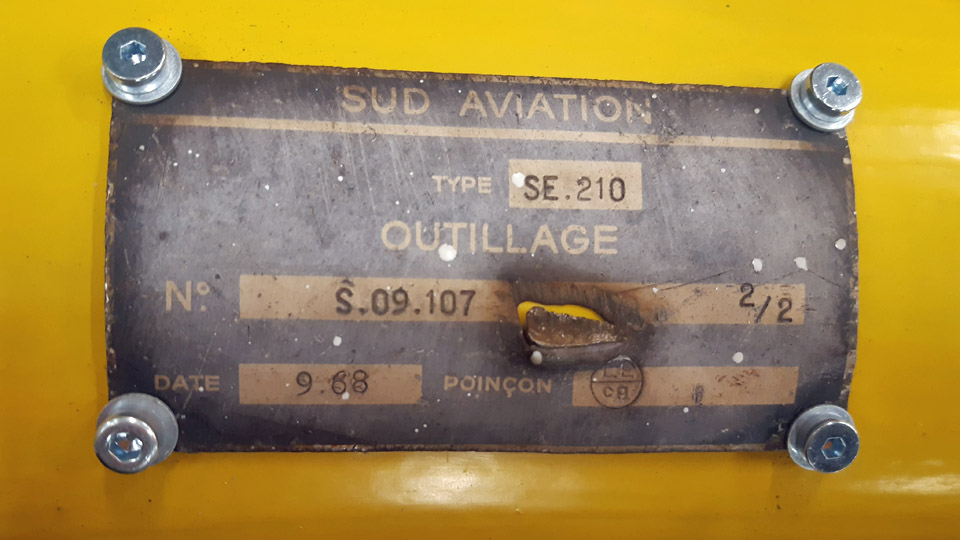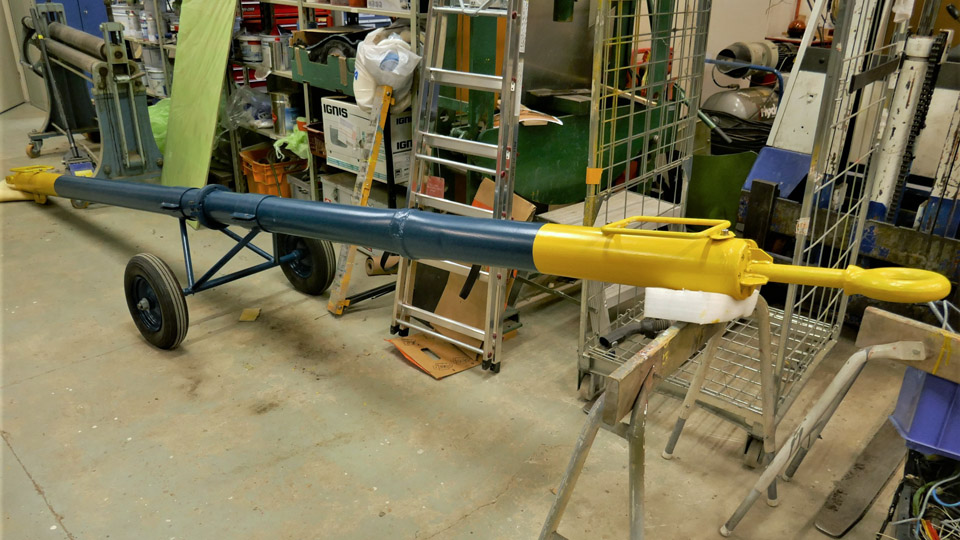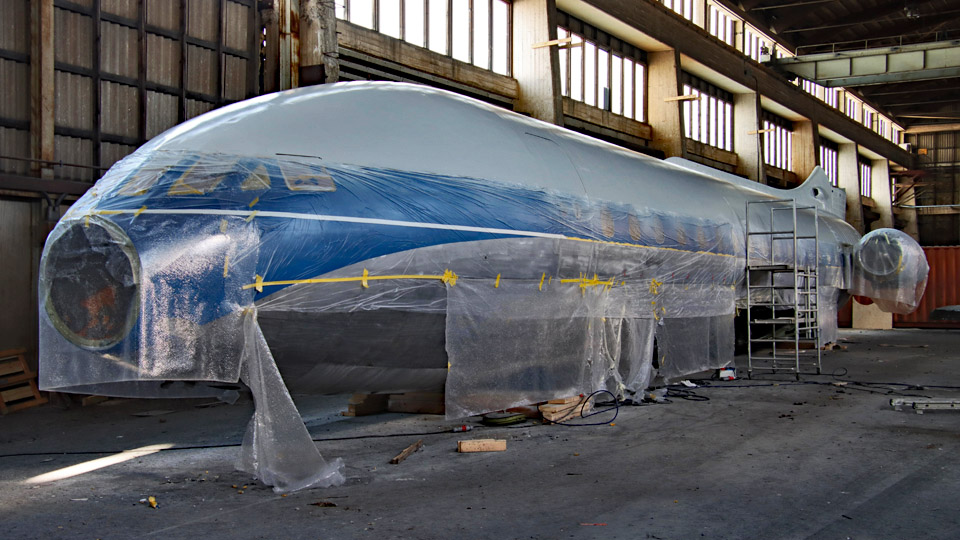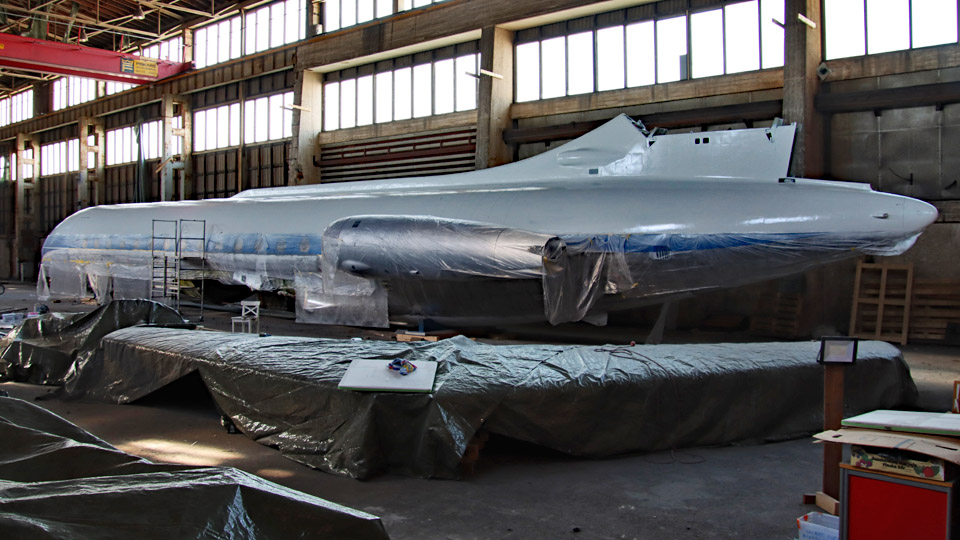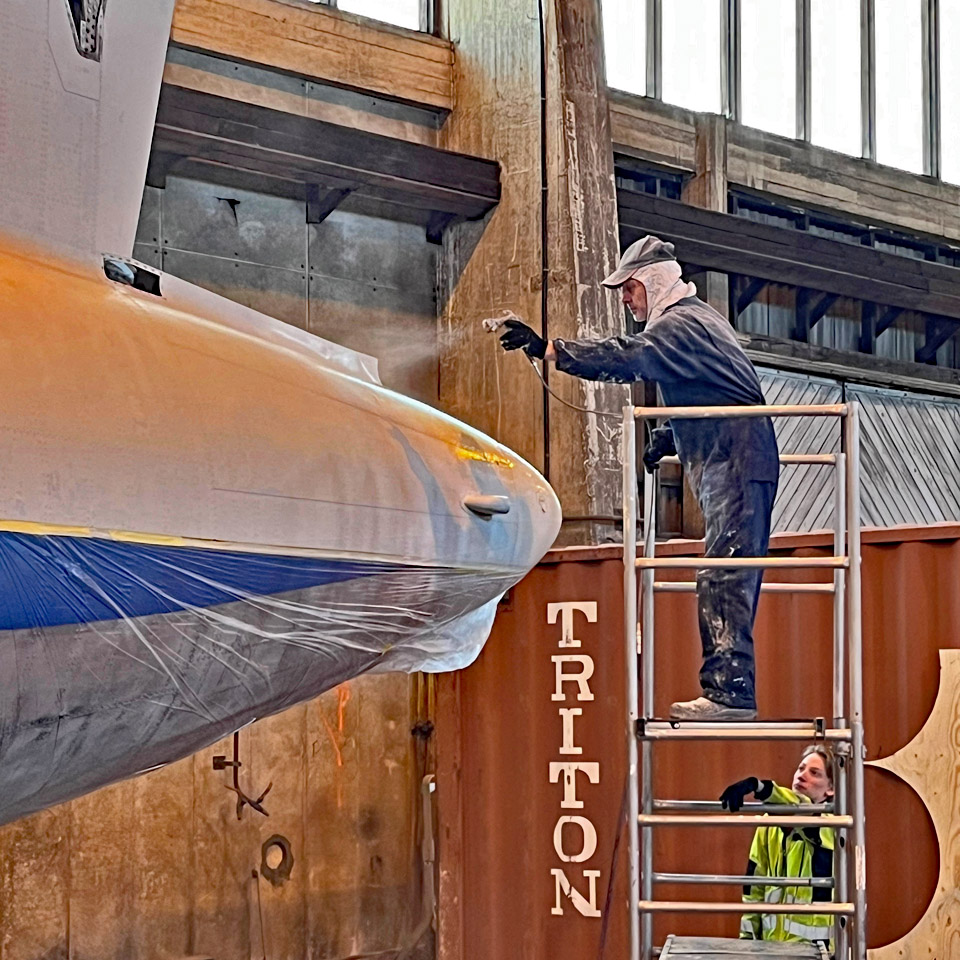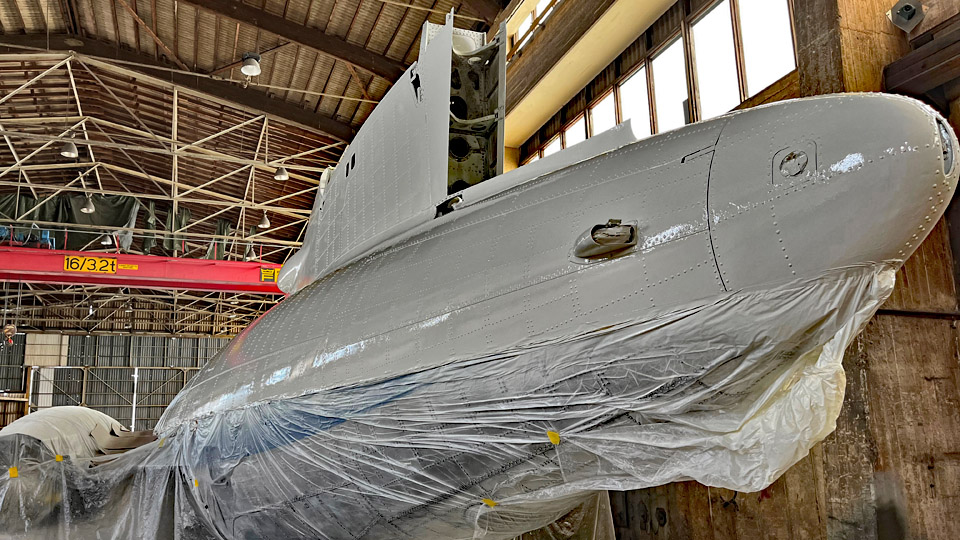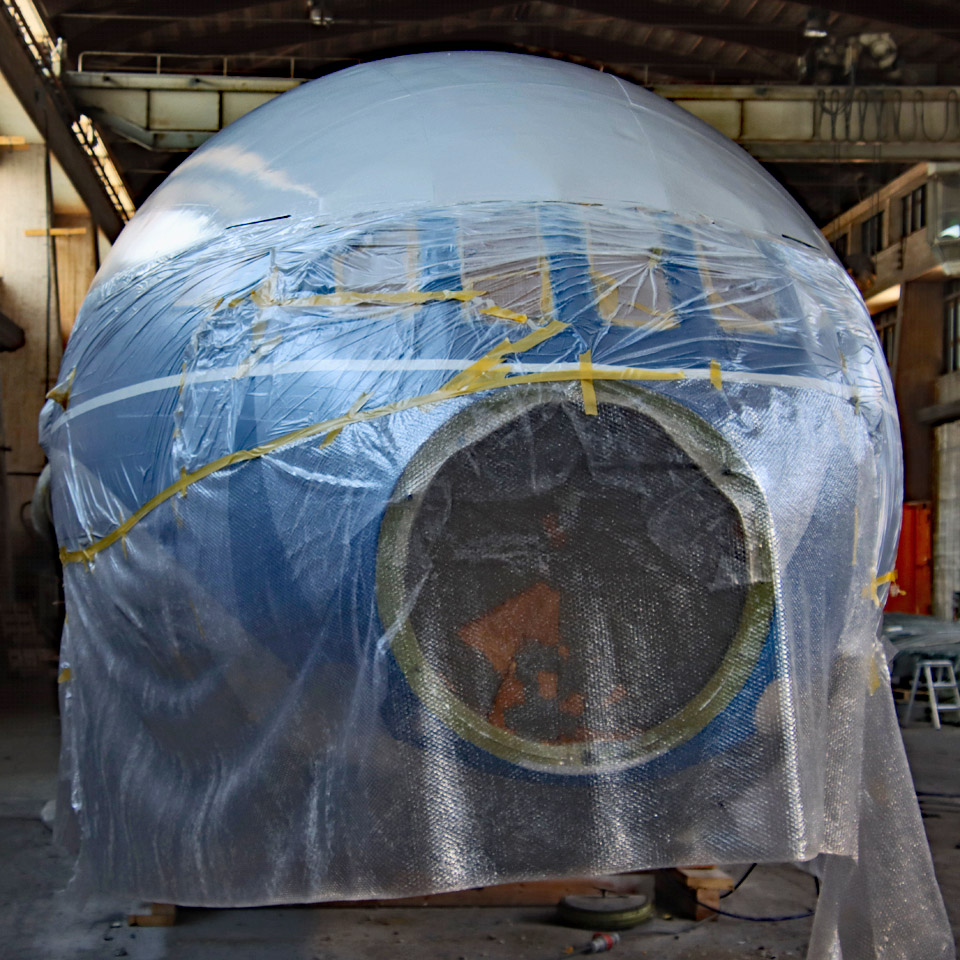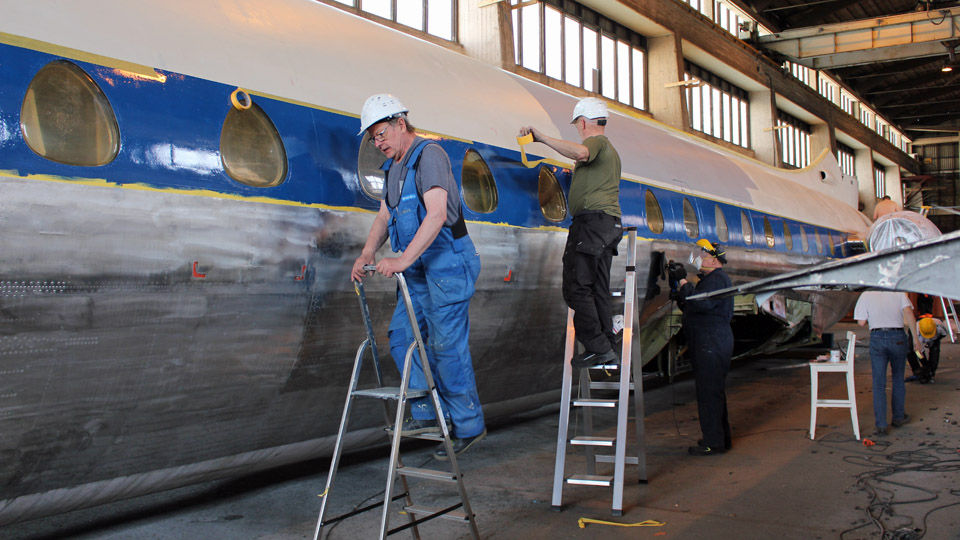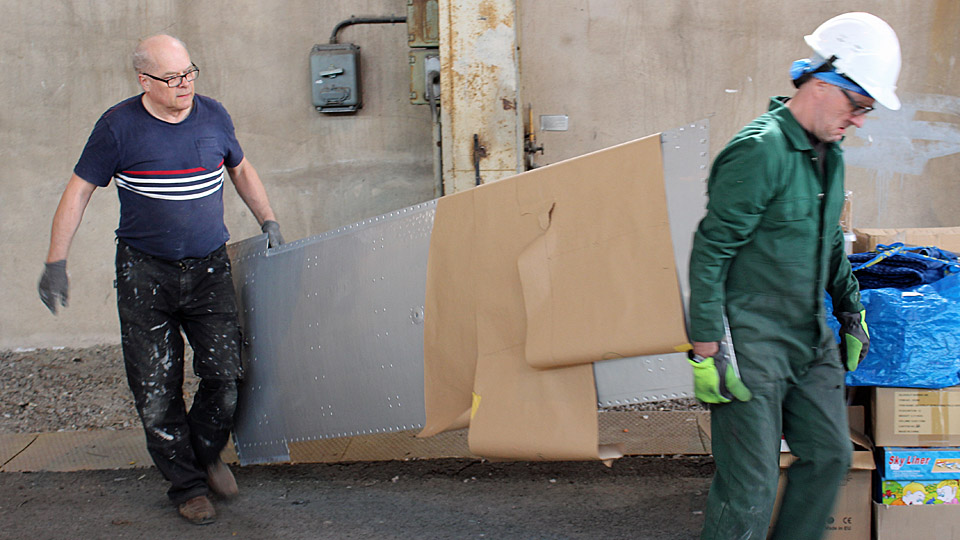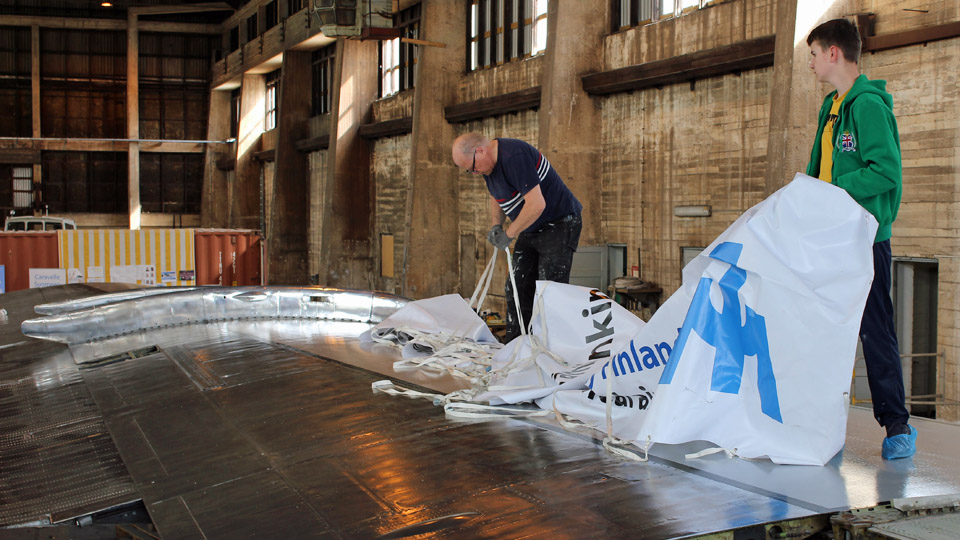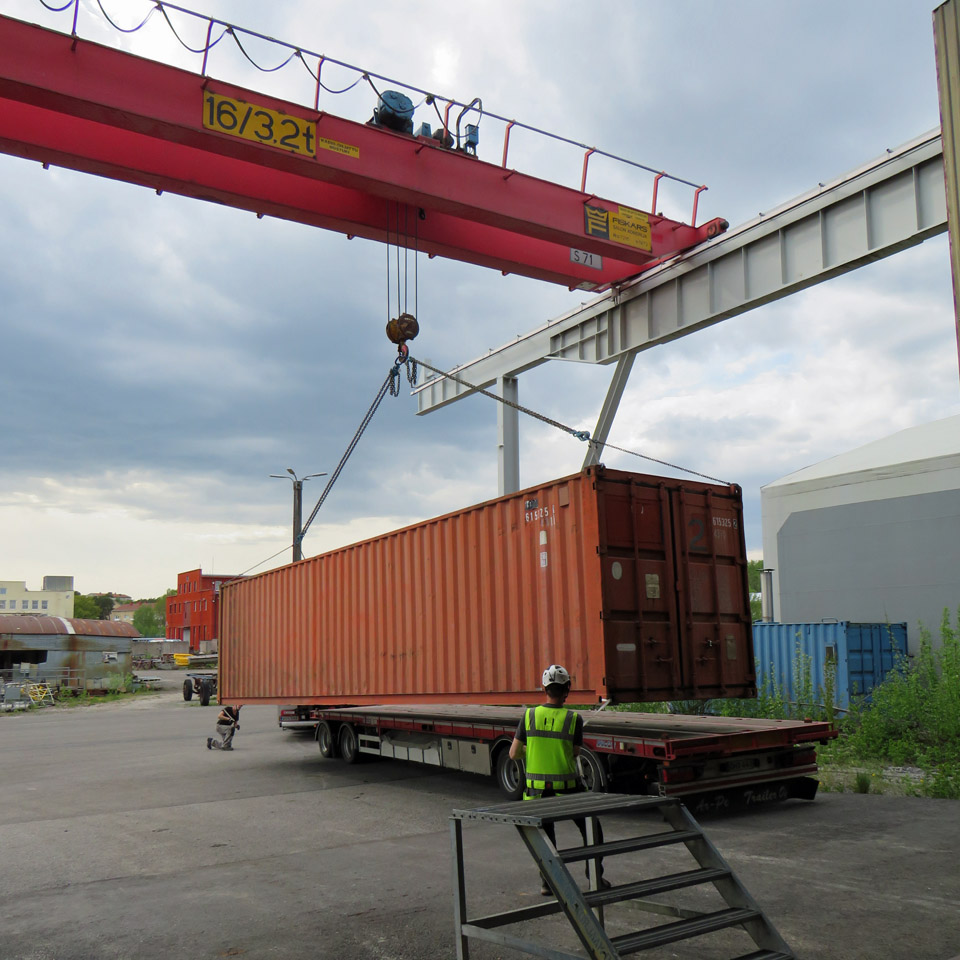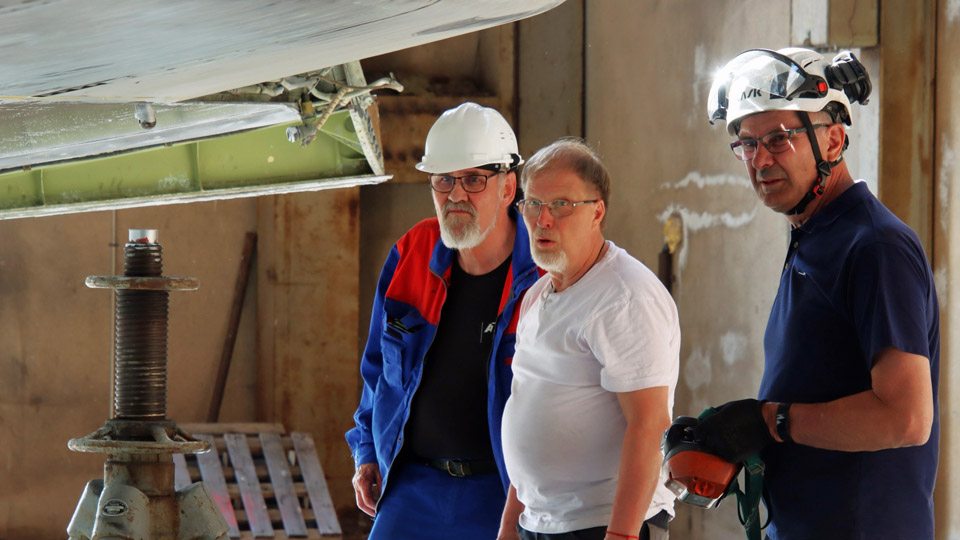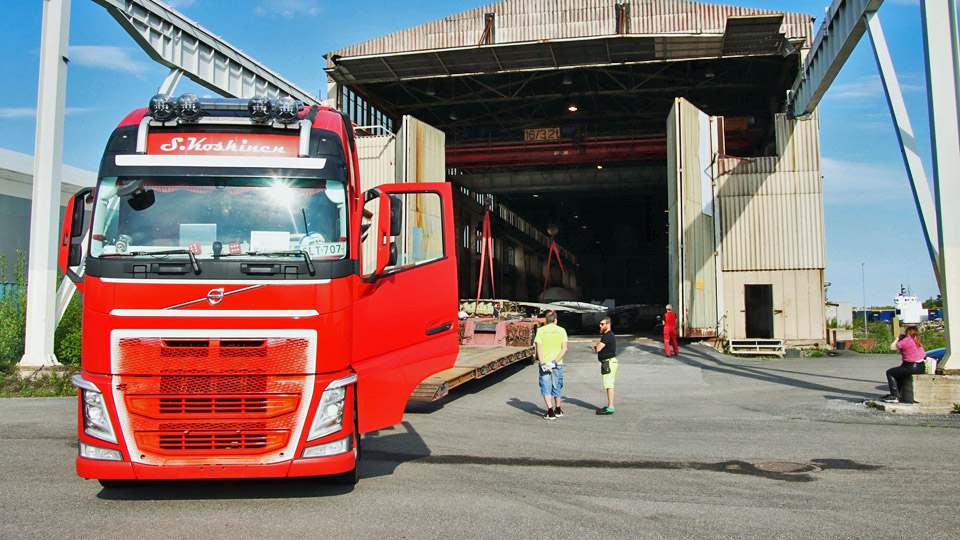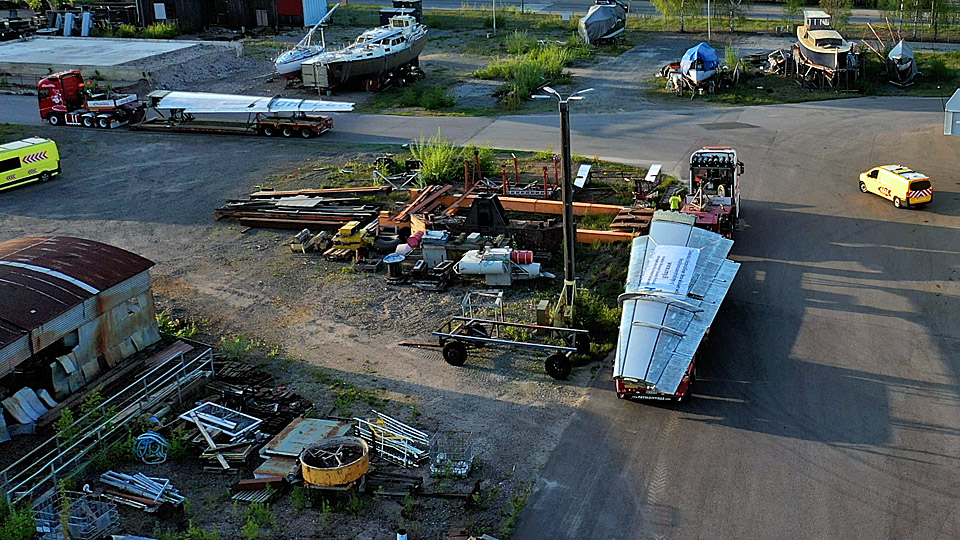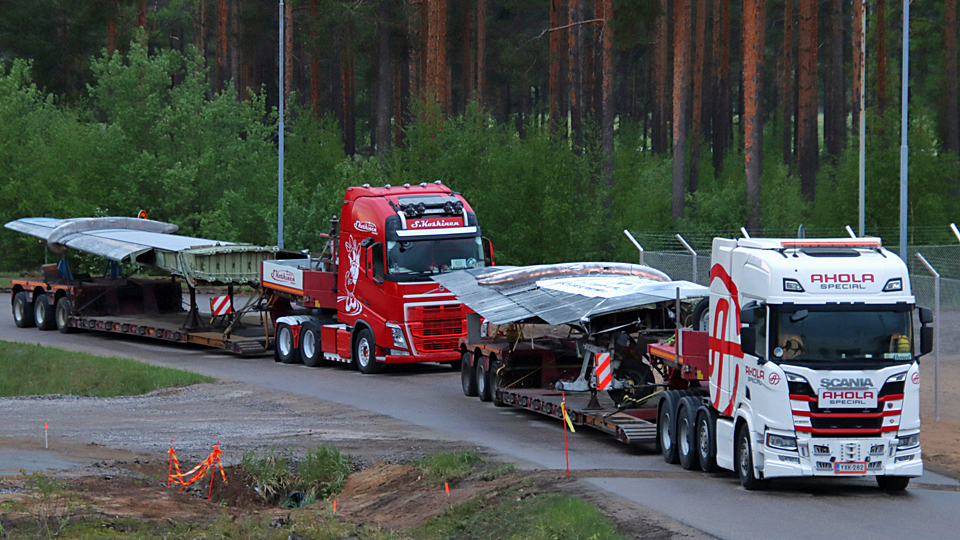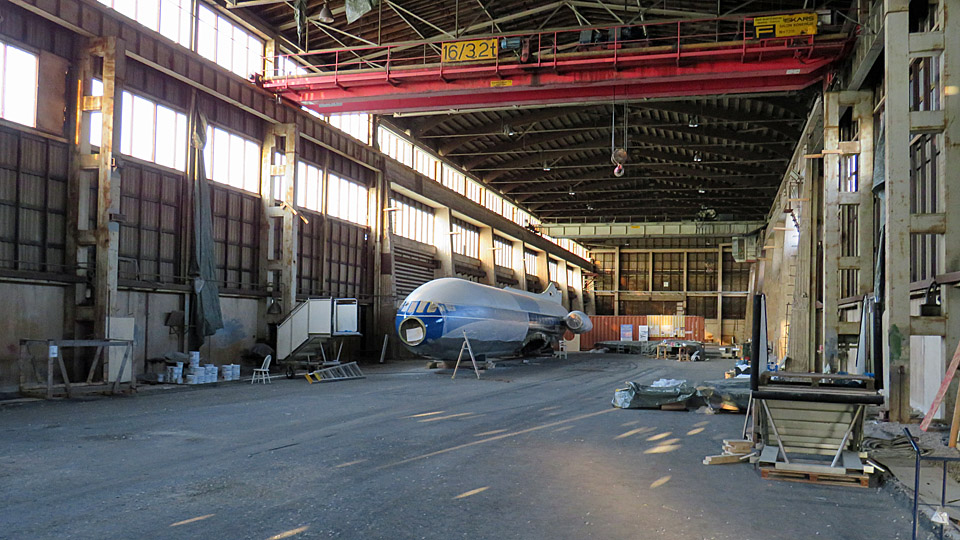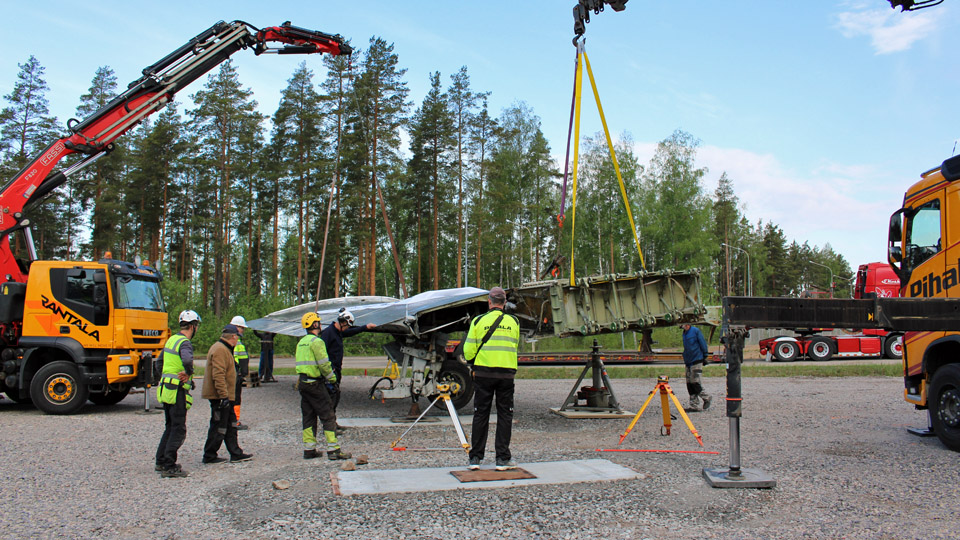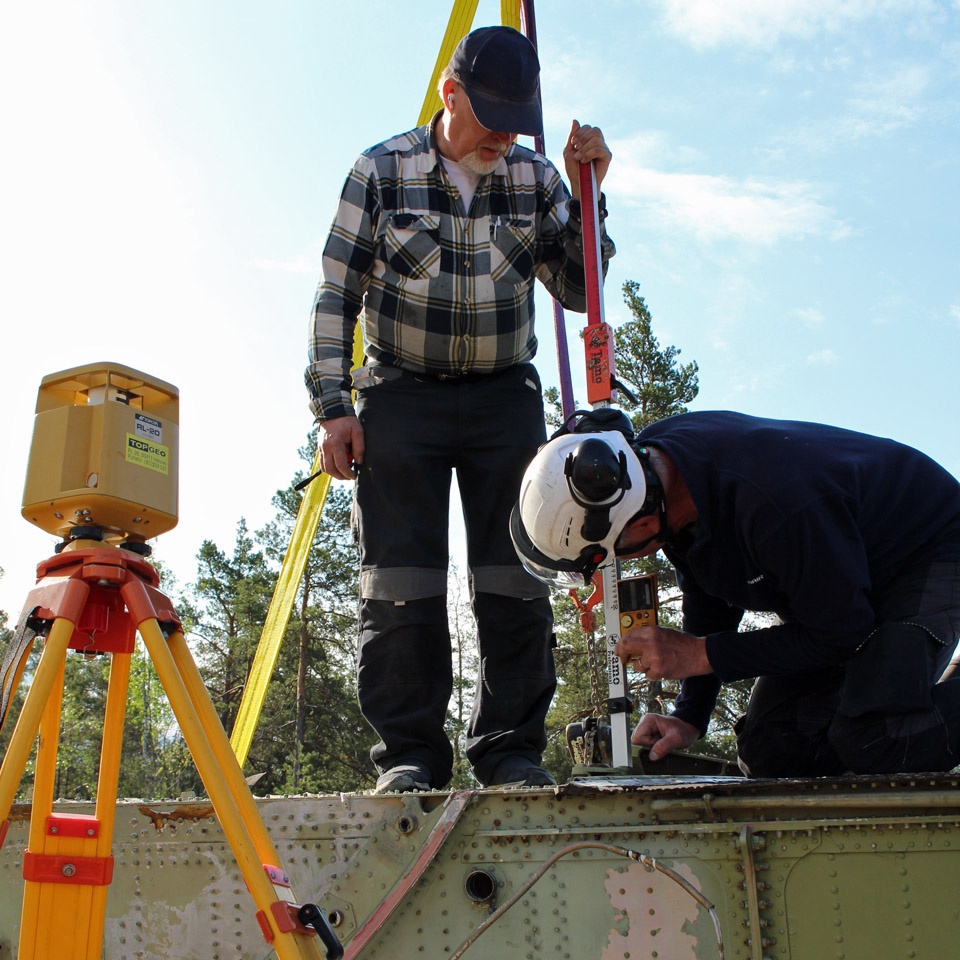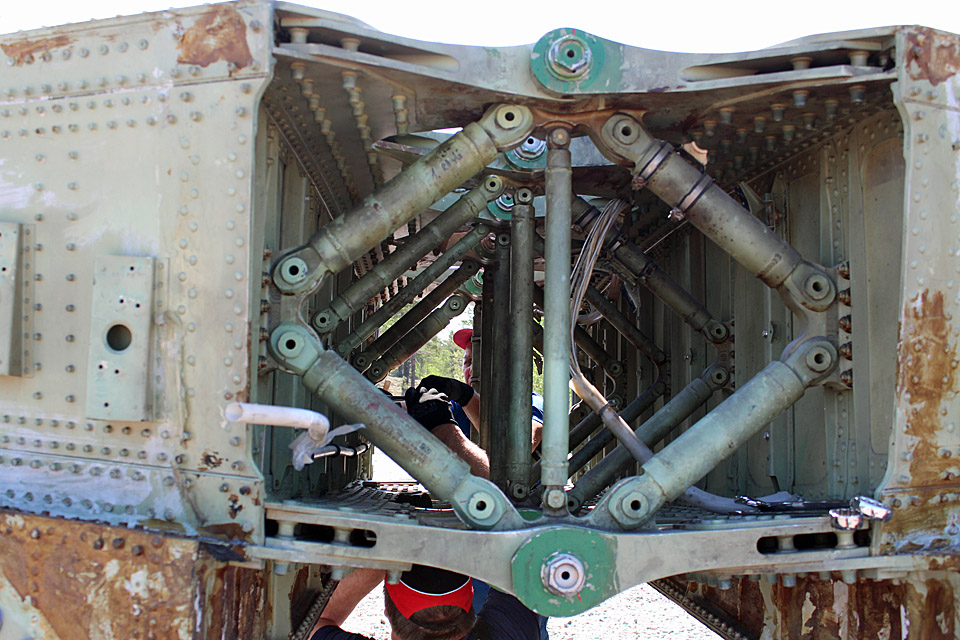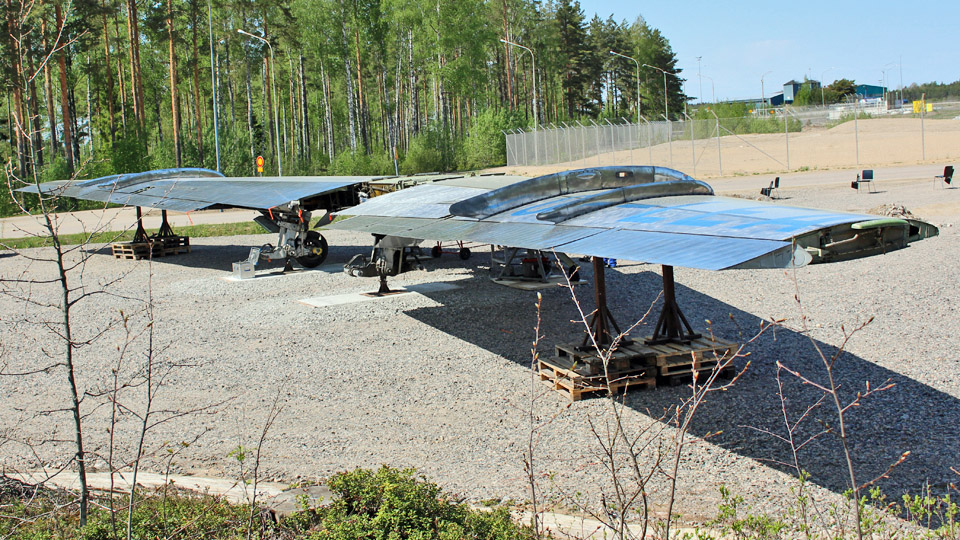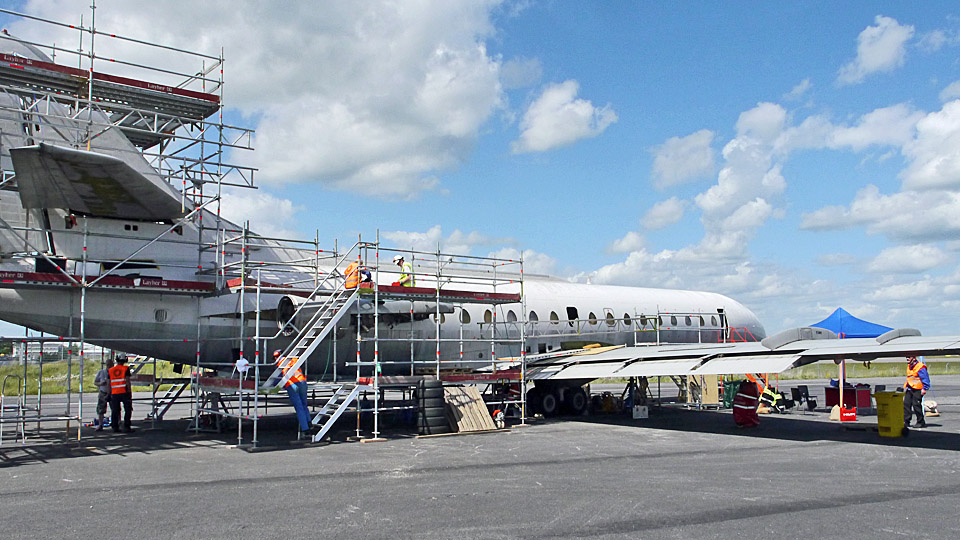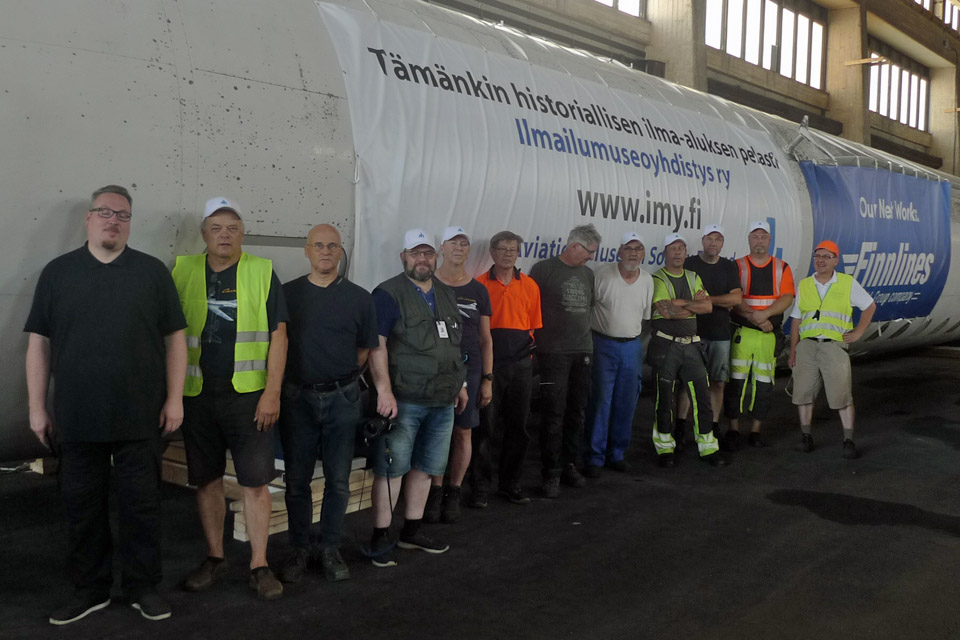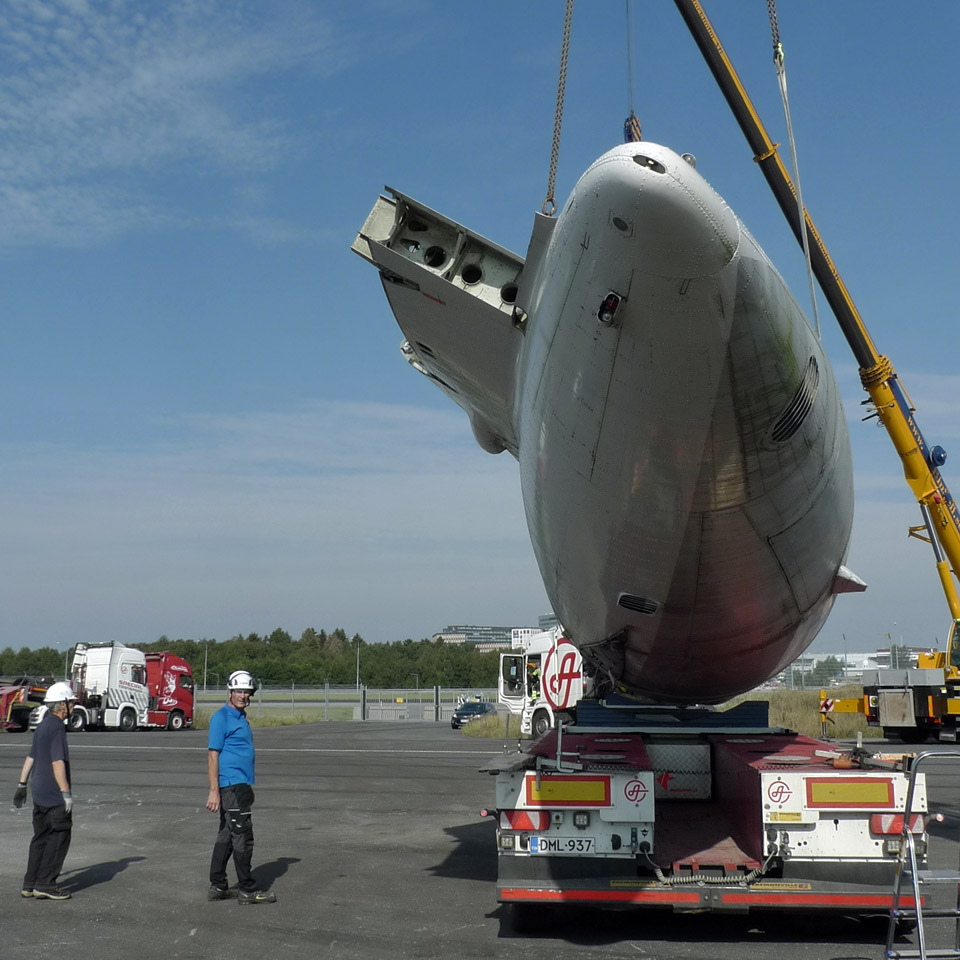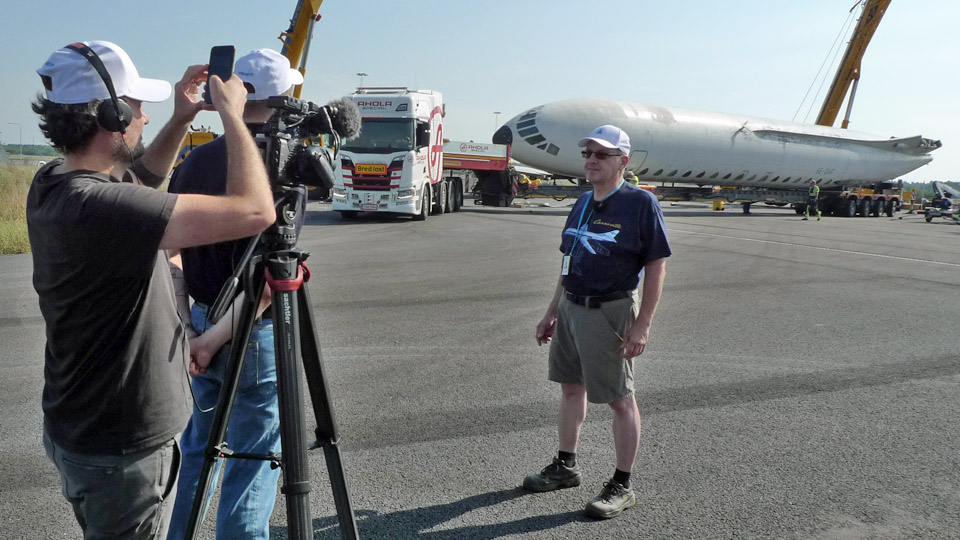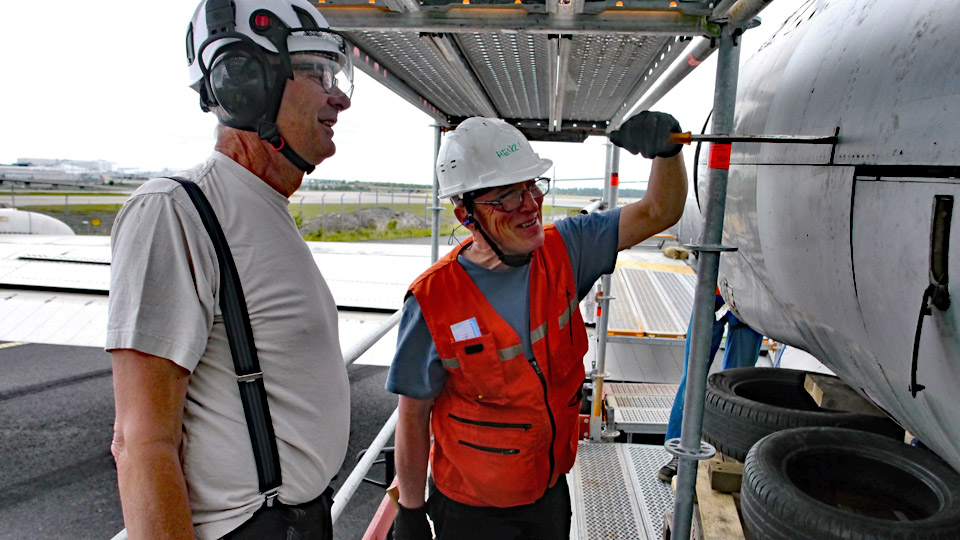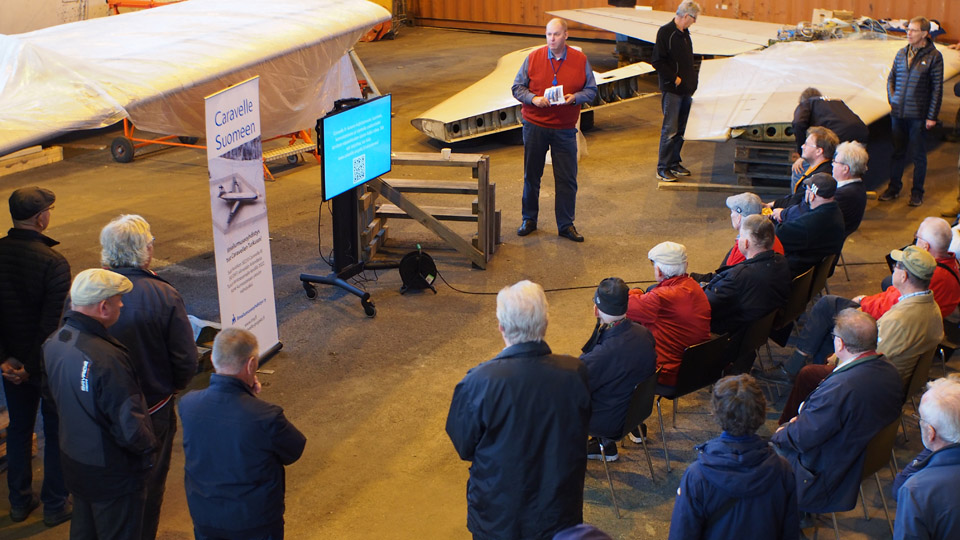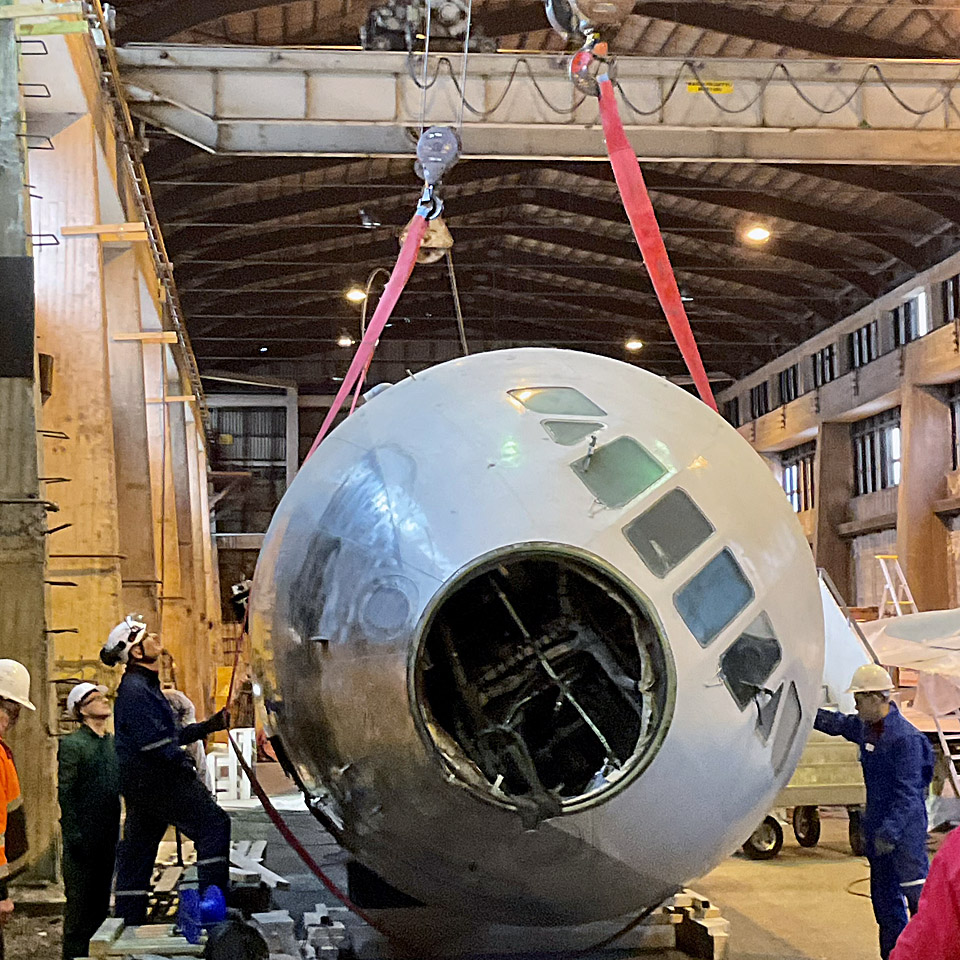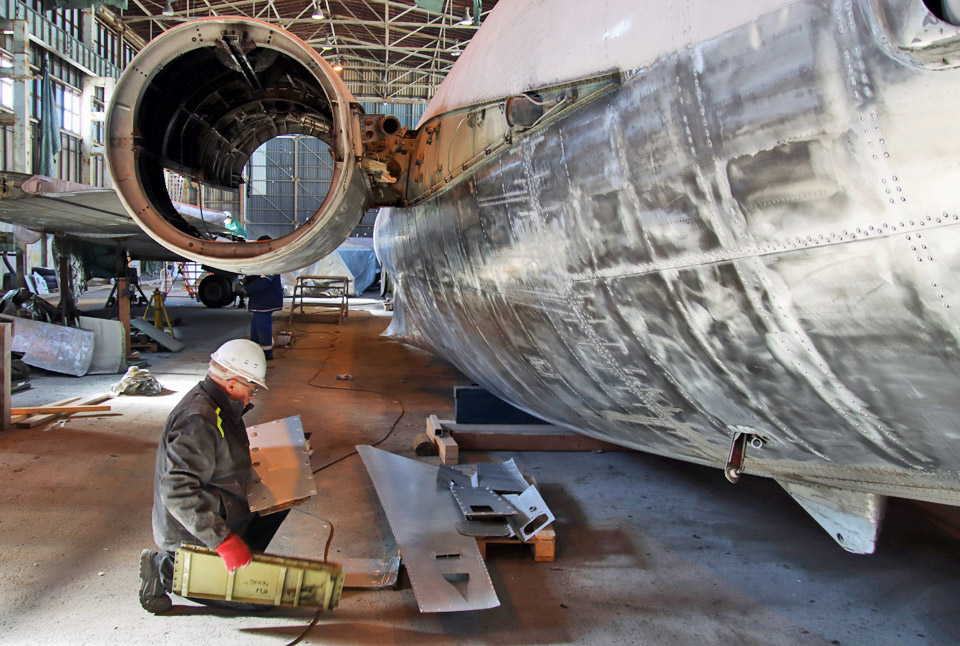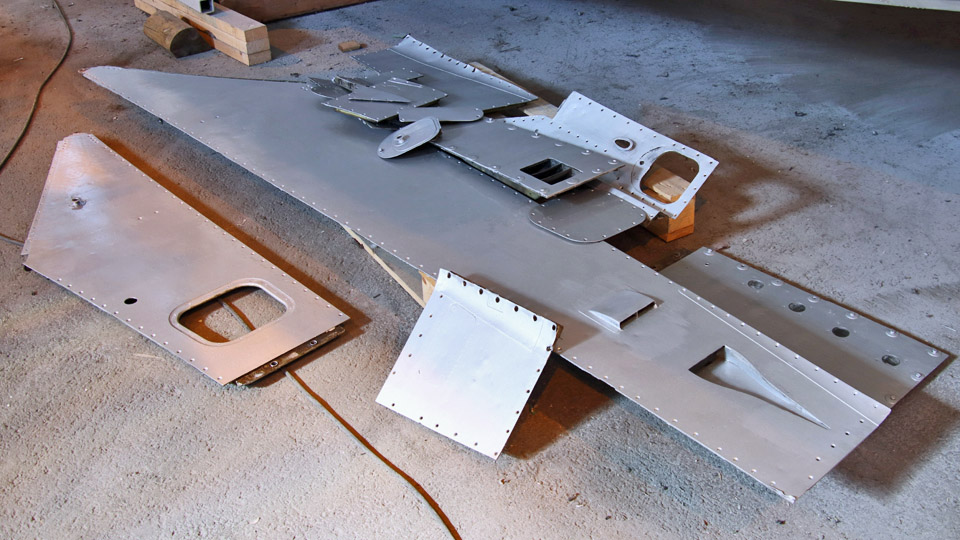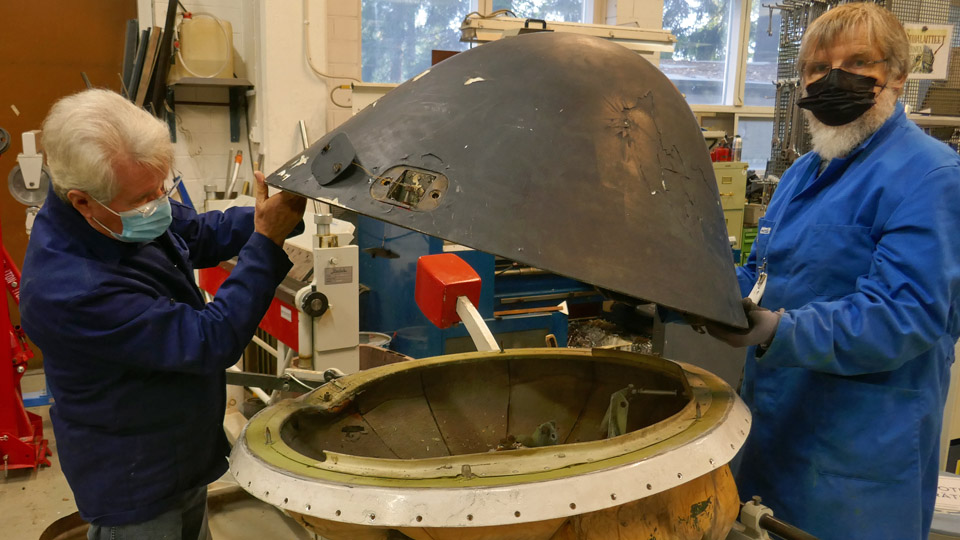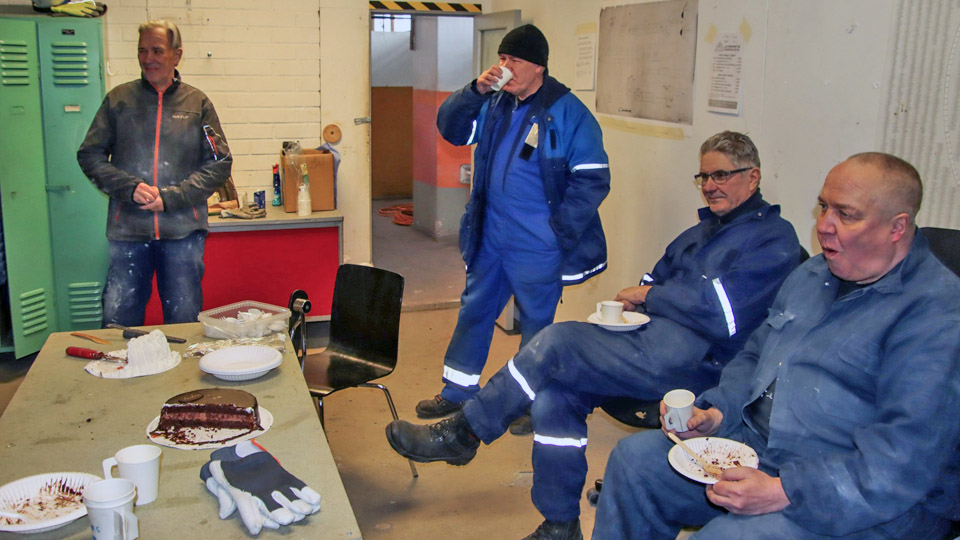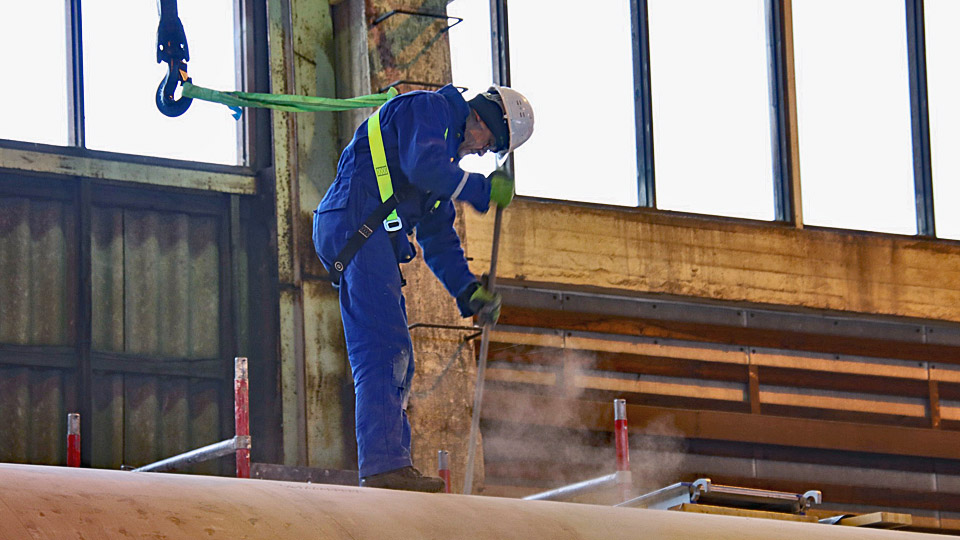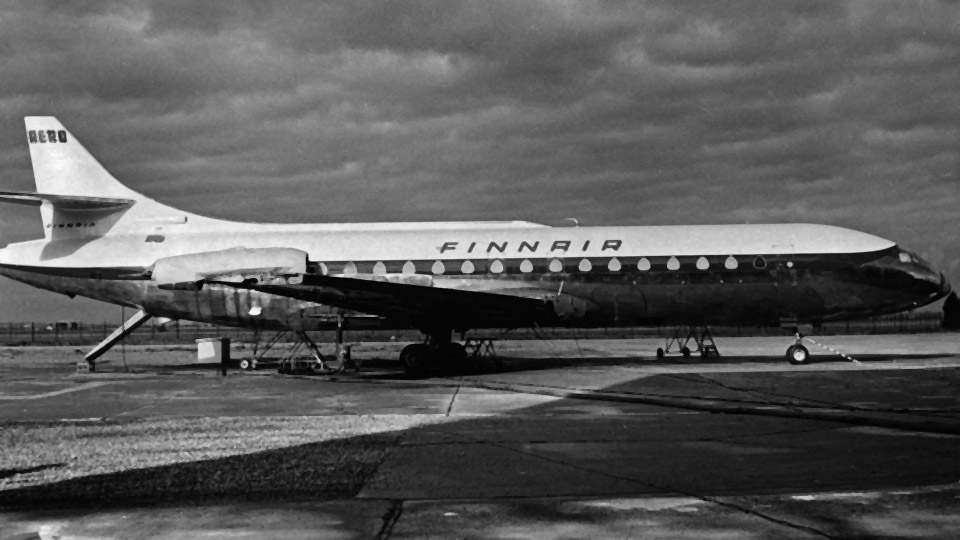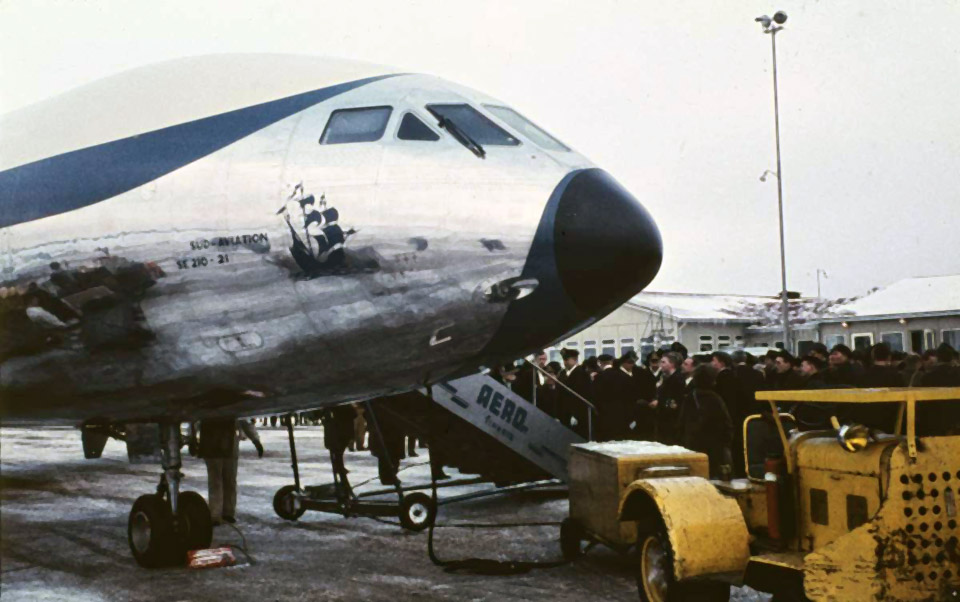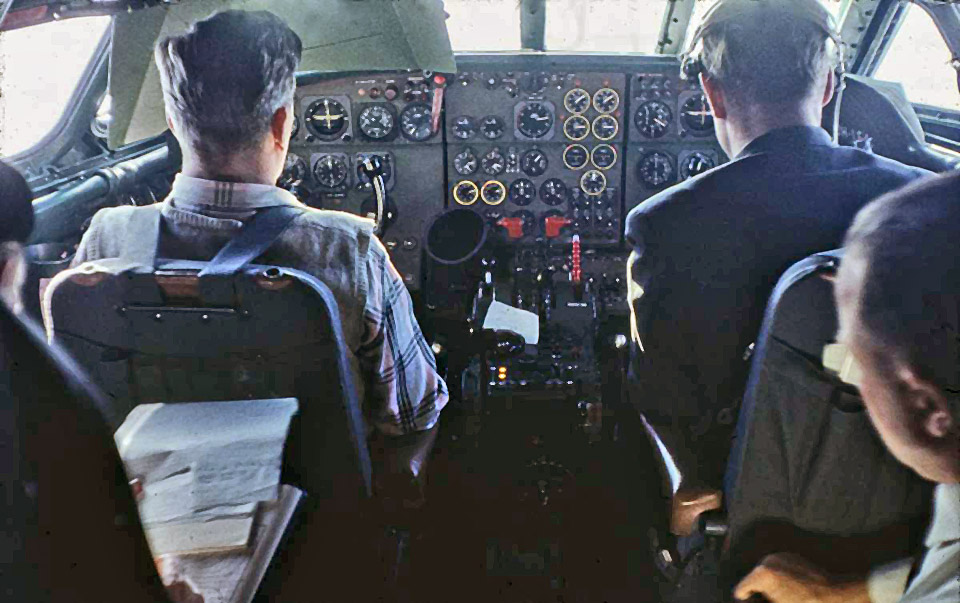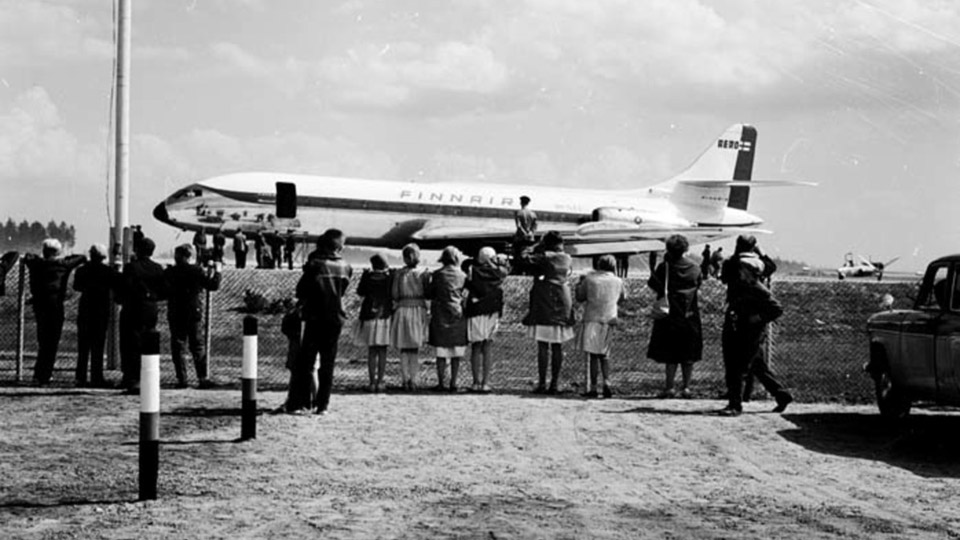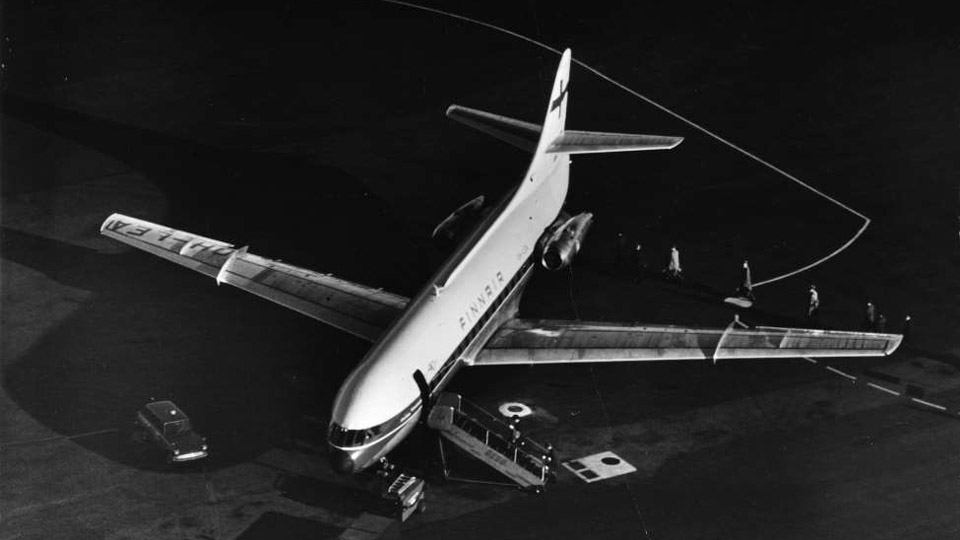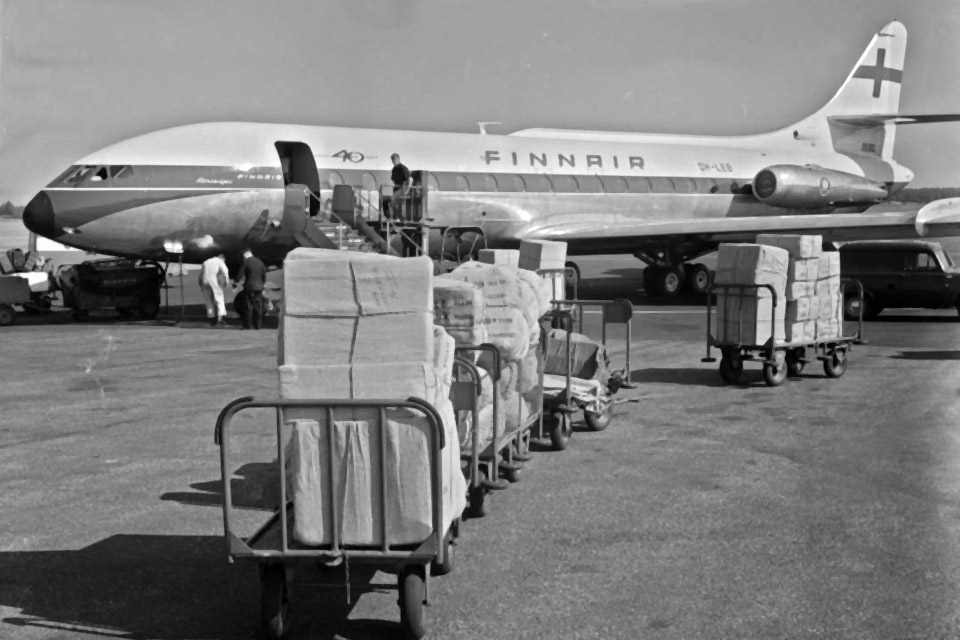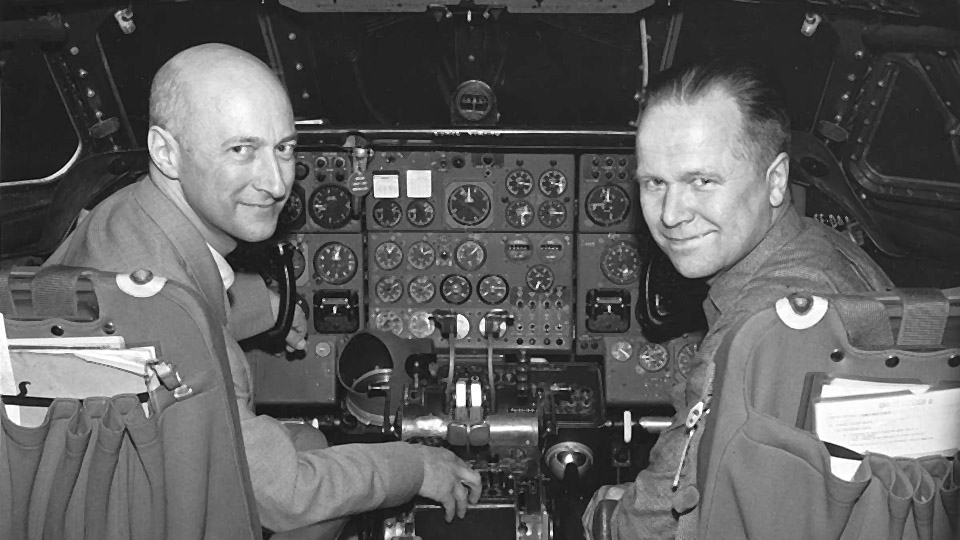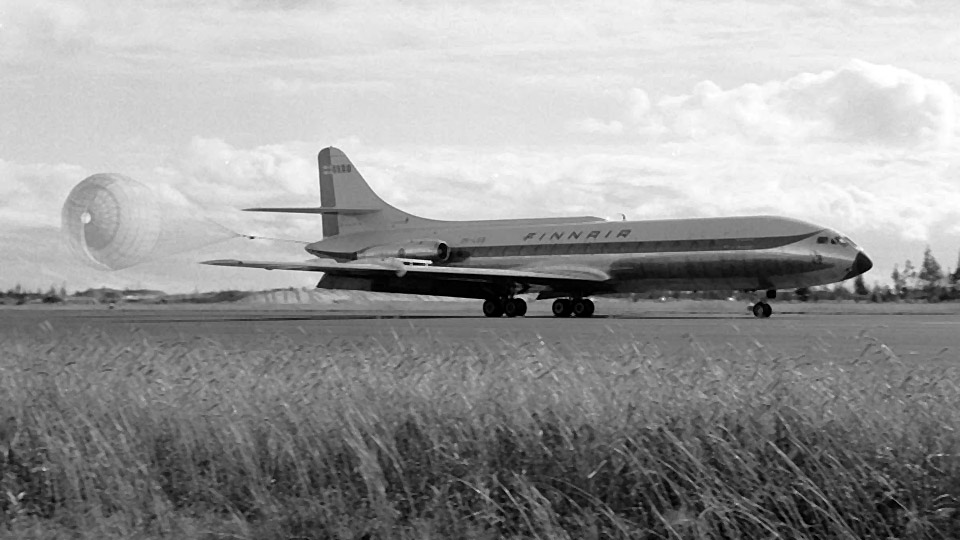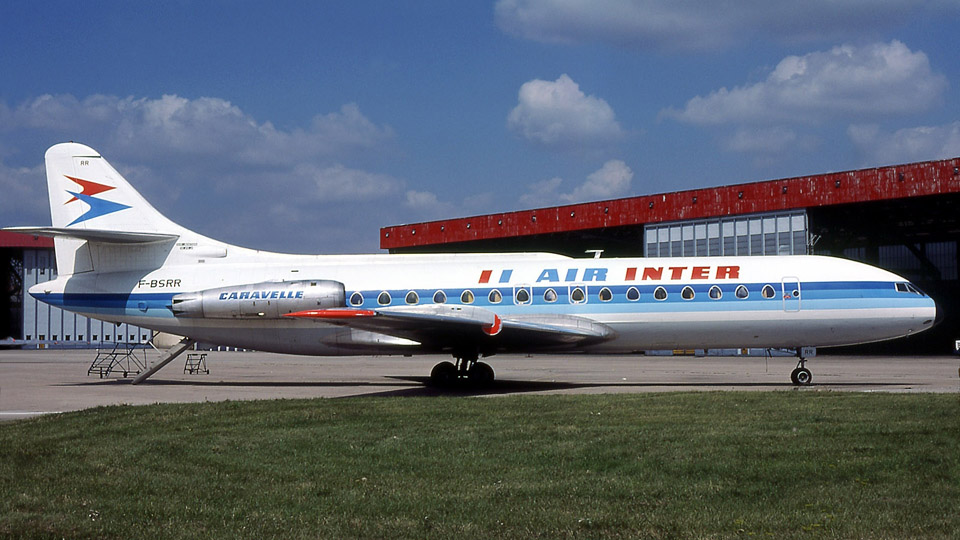Last-minute rush in PansioMaanantai 29.5.2023 klo 22.00 - Erja Reinikainen The transportation of the Caravelle’s fuselage is approaching and the Pansio team members have been busy all weekend, completing the last tasks on the fuselage. The fuselage will be lifted on a trailer on Monday evening, May 29th, and transported to the airport during the night.
Photo by Erja Reinikainen The last tasks included the stencil stickers, which were fastened on the fuselage for painting the texts and logos according to the Finnair paint scheme. The stencils came from the print cut into individual text sheets and the largest Finnair texts divided into several parts. The letters and logos which will be painted were picked away from the sheets – i.e. there are holes in the areas which are painted. When this had been done, an adhesive foil was placed on the stickers to hold the letters in shape when the stickers are fastened on the aircraft. The stickers used as stencils are placed carefully on the fuselage and the texts, logos and registration are painted with a roller, following the holes in the stencils. When the paint has dried, the stencils are removed.
Photos by Ismo Matinlauri The stencil stickers for painting Finnair and OH-LEA, which are the largest and most difficult stickers to handle, were fastened on both sides of the fuselage on Friday, May 26th. The stencils stayed well in place when the adhesive foil was removed, and the texts have been painted. Some of the stencils have already been removed, some of the texts are still drying.
Photo by Jouko Tarponen During the weekend the blue stripe on the window line was painted once more. The blue paint is drying and the preparations for transporting the fuselage are on the way. |
|
Avainsanat: aviation history, restoration, Caravelle, SE-DAF, Sven Viking, OH-LEA, Sinilintu, Bluebird |
Caravelle towbar restoredLauantai 27.5.2023 - Tuesday Club member The original towbar for Caravelle III (SE-DAF), acquired from Sweden by Aviation Museum Society, was brought along. It was used by SAS. The towbar was abandoned by SAS along with the termination of the Caravelle fleet’s career. The towbar had lain decades at Arlanda Airport along SE-DAF.
The towbar was taken under restoration at the Tuesday Club in the autumn of 2022, in a similar fashion as the derelict Super Caravelle towbar was restored, used by Finnair. The SAS towbar is of the first version made by the Sud Aviation industries. For its part the Super Caravelle towbar used by Finnair is of the third and last version. The differences between these towbars are minimal and concern mainly the wheel rack of the towbar.
Along with the spring all the parts of the towbar were refurbished and painted. The last job before assembling the towbar was to repair the wheel rack to working order. When the towbar wheel rack was dismantled in the autumn season, it was noticed that the rim of the other wheel was so far gone that it was unusable. The other wheel’s rim was sound enough to be usable with a bit of welding. A new tyre and inner tube were bought for it and one of the bearings, which had broken when the wheel was dislocated from the axle of the wheel rack. When the rim had received its blue colour, the inner tube and the tyre were fitted in place.
To replace the unusable wheel, we managed, after a spot of searching, to find a wheel with an inner tube looking like the original wheel, and fitting the towbar’s 25 mm axle. A majority of the “wheelbarrow” wheels on sale were made for a 20 mm axle. When the rim of the new wheel had also been painted blue you could hardly tell them apart. The wheels were attached on to the wheel rack’s axles, after which the test assembling of the towbar could be commenced.
The test assembling will be necessary, because the towbar will be transported in parts to the Turku Airport area, where it will be assembled on show next to the ex SAS Caravelle SE-DAF, now being restored as the Finnair “Bluebird”. By test assembling it will be ensured that the assembling in Turku will take place without surprises.
The towbar test assembly was started by setting against each other the flanges of the halves of the towbar. We had to do some thinking, because the guiding pins for the flanges of the towbar halves didn’t line up with their holes so that the lifting handles are in the same line. We established that the towbar halves must have been 180 degrees out of line of each other already when they came to Finland.
This we hadn’t noticed when dismantling the towbar, because the towbar lacked the lifting handles, which would have indicated the position. If they had been there, we would have noticed that one handle was beneath the towbar, the other one above. So our conclusion is that the towbar was wrongly assembled at Arlanda. An indication of this is that in the photos we took before the dismantling of the towbar, the metal support of the towbar which should touch the ground is sticking to the skies.
To solve the problem of test assembling we sawed off the guiding pins and pressed the flanges of both the bar halves against each other so that the lifting handles were above the towbar and lined up properly with each other. After this the flanges were locked to each other with two locking collars around them. The collars were tightened fast by their brackets with bolts. This way the towbar halves had been connected.
Now it was time to attach the wheel rack to the towbar. The wheel rack was attached to the towbar by its attachment collars. The rack wasn’t attached in the middle of the towbar, but some way on the pull loop end side of the centre of gravity. Thus the aircraft towhead end, which connects with the nose gear, weighs down and leans on the ground by its support. Finally we attached the manufacturer’s plaque on the side of the towbar. The towbar is still lacking the Caravelle logo, which will be painted on its side before it will be ready to be delivered to Turku.
The derelict towbar underwent a complete transformation at the hands of the Tuesday Club. It changed from the rusty and partly damaged towbar into a renewed one, resembling the towbars used by the Finnair Caravelle fleet. It received the same appearance as the Finnair Super Caravelle towbar we restored a year ago. Photos by Lassi Karivalo Translation by Matti Liuskallio |
|
Avainsanat: aviation history, restoration, Caravelle, SE-DAF, Sven Viking;OH-LEA, Sinilintu, Bluebird;Tuesday Club |
Caravelle's fuselage is paintedTorstai 25.5.2023 - Erja Reinikainen While the assembly team was working at the airport with the wing junction, the upper part of the Caravelle’s fuselage was being painted white in the port hall in Pansio. The spray-painting was done by a contractor (Maalausliike T. Nikander). A layer of white paint was sprayed on the fuselage surface on two consecutive days, so two layers. Finally a protective layer of lacquer was sprayed on the painted surface.
The Pansio team found spray-painting to be a challenging task for amateurs and decided to hire a professional to do the work. The project schedule doesn’t allow any practise rounds at this point. The spray-painted area looks good, thanks to the professional.
Photo by Ismo Matinlauri. Actually we ran short of time with the painting work because the spring was very cold, the temperature in the unheated hall remained low for so long that the painting couldn’t be started in the planned schedule.
Photo by Ismo Matinlauri
When the paint and lacquer on the fuselage have dried, the protecting plastic can be removed from the window line and the stencil stickers can be fastened on the fuselage for painting the airline and aircraft type texts. Photos by Jouko Tarponen except if otherwise mentioned. |
|
Avainsanat: aviation history, restoration, Caravelle, SE-DAF, Sven Viking, OH-LEA, Sinilintu, Bluebird |
Caravelle's wings are transported and assembledTiistai 23.5.2023 - Erja Reinikainen At the end of May the lease of the port hall in Pansio will terminate, and during the winter all Caravelle’s restoration, painting and assembly work has been scheduled to keep this deadline. The assembly phase started on Monday, May 22nd, when the assembly team (6 people) and an experienced aircraft polisher came to help the hard-working painters and polishers in Pansio.
Photos by Erja Reinikainen A lot happened in the hall in just half a day, when preparations were made for the transportation, painting, and assembly, which were at hand. The list of completed work is long: The lower part of the aircraft’s fuselage on the left side was polished, mainly below the wing area. A large area of shiny polished surface was completed. The ready painted and polished surfaces of the fuselage were covered with thin plastic to protect them from the spray painting of the upper fuselage, which will begin on the following day. The remaining fasteners of the wing junction were cleaned. The stabilizers, which have been painted and polished, were covered with tarpaulins. Aviation Museum Society Finland banner was fastened on one wing for the transportation as a commercial. The sea container, which has been used as a storage in the hall, was emptied. All essential aircraft parts, tools, fasteners, assembly accessories, etc. which are needed in the assembly work, were loaded into another sea container, parked outside the hall. Only the tools, paint, and stencil stickers, which are needed in the painting and polishing work during the next ten days were left in Pansio.
Photo by Erja Reinikainen The assembly team spent part of the afternoon on the aircraft’s future location at Turku airport, measuring and planning how to make sure the wings are in the correct position and can be joined.
Photo by Janne Salonen In the afternoon the sea container was packed and ready to be taken to the Caravelle’s future location at the airport. Moving the container on the trailer was not an easy task, but eventually the chains were in the correct position and the container was on the trailer. The truck carried also a couple of passenger stairs and two large jacks.
Photos by Jouko Tarponen
Photo by Juha Paju
Photo by Jouko Tarponen Loading the wings on the Ahola Special Transport trailers went well, the same procedure had been done in August 2022 when the aircraft was brought from Arlanda. The bridge cranes in the hall were used to lift up the wings, one at a time, then the trailer was reversed under the wing. When the position of the wing had been checked the wing was lowered on its supports on the trailer. The two trailers were taken to Turku airport before midnight.
In Pansio the hall was almost empty now and it is really strange that the hectic final push is almost over. The top part of the fuselage will be painted during this week and the stabilizers are waiting to be transported at the end of May.
Photos by Erja Reinikainen. On Tuesday, May 23rd, the wing assembly work began at Turku airport. In the morning two mobile cranes were on site bright and early. Before the wings were moved, the aircraft’s future position was measured carefully and marked on the concrete slabs, which had been dug into the ground. The left wing was lifted from the trailer. Finding the correct position required some work and patience from the crane crew and the assembly team members who were measuring and operating the jack. Finally the wing was lowered on the ground, its weight resting on the support under the landing gear, on a wing jack and on two wing supports. The right wing was aligned into place, inch by inch, using the two cranes. The wing junction brackets met each other, and they were secured using the assembly pins which had been made to assist in the aligning. When some final adjustments had been made on the wing position, the wing junction expansion pins could be installed, and the wing lowered on its supports. By mid-day all expansion pins were in place and the assembly team could sigh with relief: everything had gone far better than expected.
Photo by Erja Reinikainen The wing junction’s canted brace struts were installed into place, then all tools and assembly accessories were collected into the sea container and the aircraft was surrounded with warning tape. The assembly will be continued next week when the fuselage has been painted and it will be transported from Pansio and lifted on the wing. |
|
Avainsanat: aviation history, restoration, Caravelle, SE-DAF, Sven Viking, OH-LEA, Sinilintu, Bluebird |
Caravelle salvage crew, part 1Sunnuntai 9.4.2023 - Erja Reinikainen Several blogs have been written about the Caravelle III aircraft which is under restoration in Pansio, about its history and the progressing of the work. Without enthusiastic volunteers there wouldn’t be any activity, so it is time to talk about the people behind this project. This blog introduces an overview of the tasks which are needed before the aircraft is ready for display. I hope to continue with some personal interviews in the following blogs.
Photo by Reino Myllymäki In the early phases of the project Janne Salonen, the chairman of Aviation Museum Society Finland had a key role. He has good connections to Jan Forsgren, who is a member in the voluntary organisation Arlanda Aviation Museum’s Friends (Arlanda Flygsamlingars Vänner). In spring 2020 Jan informed Janne that the owners of the Arlanda Aviation Museum, the representatives of Swedish National Maritime and Transport Museums, had decided to give up the Caravelle. The first assessments on bringing the aircraft to Finland were carried out by the board of Aviation Museum Society Finland. Also the official decision on launching this project was made by the board.
Photo by Raímo Korpi The seven members of the board have supported and promoted the Caravelle project all along, without reserve. The project outlines and the major acquisition decisions have been made by the board. The rental agreement of the Pansio port hall and the final display site at Turku airport have been negotiated by the chairman and the board. Also the details including major costs, such as the transportation of the aircraft parts, have been negotiated and approved by the board. Finding funding for the project has been a long and challenging effort. Funding and sponsoring arrangements are negotiated by the chairman and board members.
Photo by Raímo Korpi Aviation Museum Society’s board member Reino Myllymäki is responsible for the public relations of the project. He is assisted by two or three bloggers and by Jouko Tarponen, who is responsible for photographing the project’s progress in Pansio. All blogs and Caravelle news in the society’s Feeniks magazine are published also in English and this task is taken care of by two volunteers.
Photo by Raímo Korpi The members of Aviation Museum Society Finland were informed about the Caravelle project at an early stage. In the beginning of year 2021 the search for the technical team members was launched. During the spring the former Finnair mechanics Markku Ahokoski, Martti Saarinen and Kari Nyman answered the challenge. During the winter 2021-22 they led the discussion and assessment on how the aircraft could be disassembled and transported to Finland. This team has now been working in the project for a couple of years.
Photo by Reino Myllymäki The disassembling (and re-assembling) of a passenger jet airliner means that a huge number of details need to be planned. The technical team has faced the task undaunted by the scale of the job. The task has included decisions on the main issues (how to disassemble the fuselage off the wing?), practical solutions (how to lift and turn the aircraft using the bridge cranes in the hall?), taking care of the small odds and ends (how to keep track of the origin of all screws and bolts which have been unfastened?), not to mention all kinds of issues which we ordinary non-technical people are not even aware of. These tasks have required good professional skills and the ability to foresee problems, and furthermore, also cool-headed decision making when something needs to be done which hasn’t been done before.
Photo by Ismo Matinlauri In the spring 2022 Ismo Matinlauri joined the technical team. His work has included recruiting the team of volunteers in Turku as well as coordinating the restoration work. Ismo has also managed all kinds of fixing and acquisition tasks. For Ismo the Caravelle project is almost a full-time job when the Turku team works in the hall three days a week and the remaining two days are spent running errands and acquiring material.
Photo by Ismo Matinlauri During the project several people, many of them former technical staff from Finnair, have participated in solving technical problems and dismantling or restoration work. A group of enthusiastic volunteers without aircraft work experience has also joined the project, wanting to have a part in making aviation history. In summer 2022 there were about twenty volunteers from Aviation Museum Society Finland (and one or two volunteers from Sweden) disassembling the aircraft in Arlanda. This group is invited to join the Caravelle polishing session which will be arranged in Pansio this spring.
Photo by Jouko Tarponen A team of about ten Turku area volunteers have been restoring the aircraft during the winter, working on three days a week. I take my hat off to these volunteers, they have been cleaning and sanding Caravelle’s surfaces for several months now! The sanding work is finally approaching the end and there is polishing and painting ahead.
Photo by Lassi Karivalo In addition to Pansio, Caravelle restoration work is ongoing also in Vantaa, where two or three people have been preparing for sheet-metal work and repairing parts which have been brought from Pansio. The Tuesday Club of Aviation Museum Society has also participated in the project by repairing e.g. the damaged Caravelle’s radome and nose bulkhead.
Photo by Jouko Tarponen Based on the estimations presented in this blog, it can be estimated that about 40 people have participated so far in the Caravelle project, some of them joining the team of volunteers for a single effort (such as the disassembling), others working on the project almost daily. Warm thanks to you all! Without volunteers this project would never have been possible. Hopefully in the following blogs we can read why they joined the team. |
|
Avainsanat: aviation history, restoration, Caravelle, SE-DAF, Sven Viking, OH-LEA, Sinilintu, Bluebird |
Caravelle III OH-LEA "Sinilintu" ("Bluebird")Keskiviikko 29.3.2023 - Erja Reinikainen Suomeksi The Caravelle III, which was brought from Arlanda to Finland by Aviation Museum Society Finland, served in the SAS fleet with registration SE-DAF and name Sven Viking. In Pansio the aircraft is being restored to Finnair colours as its first Caravelle OH-LEA, Sinilintu (Bluebird). This blog tells about the long and colourful history of this aircraft.
Photo by Finnish Aviation Museum photo archive / Ilmailu magazine In 1958 the Finnish airline Aero Oy (later Finnair) ordered three Caravelle IA passenger jets from the French Sud Aviation aircraft factory. The Finnish airline was one of the forerunners of air travel and was the fourth airline to order the new passenger jet type, after Air France, SAS and the Brazilian Varig.
Photo by Finnish Aviation Museum photo archive / Börje Hielm. The first jet aircraft in Finnish civil aviation was Sud Aviation Caravelle IA, which got the registration OH-LEA and was named Sinilintu (Bluebird). It was handed over in Toulouse on February 21st, 1960, and it arrived in Finland on February 22nd, 1960. The aircraft was flown to Finland by Olli Puhakka, who was a former fighter pilot and Knight of the Mannerheim Cross. The co-pilot on the flight was Olavi Siirilä, also a former war pilot. Among the guests of honor on the flight were minister of transport Arvo Korsimo, Aero Oy’s managing director Leonard Grandell, chief editor of the Helsingin Sanomat newspaper Yrjö Niiniluoto and maritime counsellor Antti Wihuri.
Photo by Finnish Aviation Museum photo archive / Börje Hielm. During the spring 1960 the Bluebird was followed by Sinisiipi (Bluewing, OH-LEB) and Sininuoli (Blue Arrow, OH-LEC). These three aircraft were later modified to type Caravelle III. The fourth aircraft was already a Caravelle III when it was purchased in 1962. It was named Sinipiika (Blue Maid, OH-LED).
Photo by Finnish Aviation Museum photo archive / Ilmailu magazine
Photo by Finnish Aviation Museum photo archive / Ilmailu magazine During its service in the Aero fleet the Bluebird appeared in three different paint schemes. It was delivered in its first appearance, where the rudder was blue, and the name Aero was written in large on the upper part of the vertical stabilizer. In the second paint scheme the rudder was blue and a blue cross on the vertical stabilizer replaced the text. Otherwise the paint scheme was identical to the first one. The third painting was done when the aircraft was updated to type Caravelle III. This is the appearance into which the former SAS SE-DAF will now be restored. The paint scheme can be seen in the visualization image on the front page of the Caravelle-project. When Finnair celebrated its 40th anniversary, a special anniversary logo and text were added on the aircraft.
OH-LEB. Photo by Finnish Aviation Museum photo archive / Finnair Oyj In the Finnair fleet the Caravelle had 16 seats in the first class and 75 in the tourist class. Starting from April 1960, the Caravelles operated on routes to European cities. In the beginning the destinations were Stockholm, Copenhagen and Frankfurt, followed by several other cities during the coming years. The Caravelles replaced the Convair 440 Metropolitan piston engine aircraft in Europe, and they were transferred to domestic routes. In late 1961 Oulu was the first domestic route operated with passenger jets.
Olli Puhakka and Olavi Siirilä in the cockpit of Eskil Viking (SAS). Photo by Finnish Aviation Museum photo archive / Ilmailu magazine A Finnish speciality was flying the Caravelles with only two pilots, when other airlines had two pilots and a mechanic in the cockpit. Another remarkable difference was the surrounding and existing environment, which was why the Aero Caravelles had a brake parachute installed. The Caravelle III had Rolls Royce Avon engines and there was no reverse thrust in them to assist in the braking. The brake parachutes were only used when the friction conditions on the runway were really poor. The pilot opened the brake parachute by pulling a handle during the landing run. When the aircraft left the runway, the parachute was released by pulling the same handle. The technical ground crew then collected the parachute for reassembly.
OH-LEB “Sinisiipi” (“Bluewing”) uses drag chute. Photo by Finnish Aviation Museum photo archive / Ilmailu magazine. The OH-LEA Bluebird flew its first flight on February 11th, 1960. It belonged to the Finnair fleet in 1960–61 and logged 9091 hours. The aircraft was sold back to Sud Aviation on December 4th, 1962, and it was flown to France on September 20th, 1964. The following user of the Caravelle was the German LTU, which got the aircraft on February 12th, 1965. It was registered as D-ABAF and named Nordrhein-Westfalen. The next user was Transavia Holland. It rented the aircraft between January 30th, 1969, and April 16th, 1970, as PH-TRM.
F-BSSR in August 1978. Photo by Michel Gilliand via Wikimedia Commons. From the Netherlands the aircraft returned to France, where it was registered as F-BSRR in Air Inter’s fleet where it flew from March 19th, 1971, until December 1980. During this time the Caravelle was rented to Royal Air Maroc and SNIAS, among others, having different registrations. Air Inter sold the aircraft to Altair in Italy, where it was registered I-GISA. It was removed from service in September 1983 with 37 532 hours on its log. But the story doesn’t end here. From Italy the aircraft was bought to Congo by IAC Airlines. In Congo it was registered 9Q-CPS and it was named Santeny. The last airline to use the Caravelle was Air Transport Service, which flew it until 1994. The Caravelle was scrapped in 1996 at the N’djili international airport in Kinshasa, Congo. As we can see, OH-LEA was an individual with a long history. It served for 36 years, and it had more user airlines and operators than any other first generation Caravelle. Following sources have been used for this blog:
|
|
Avainsanat: aviation history, restoration, Caravelle, SE-DAF, Sven Viking, OH-LEA, Sinilintu, Bluebird |


